Accounting Systems and Processes - Desklib
VerifiedAdded on 2022/10/04
|19
|3894
|311
AI Summary
This document covers the journal entries, T-account, adjusted trial balance, income statement, balance sheet, and statement of equity changes for Pete's Handyman Services. It also analyses the history of accounting and ethical principles in the code of ethics.
Contribute Materials
Your contribution can guide someone’s learning journey. Share your
documents today.
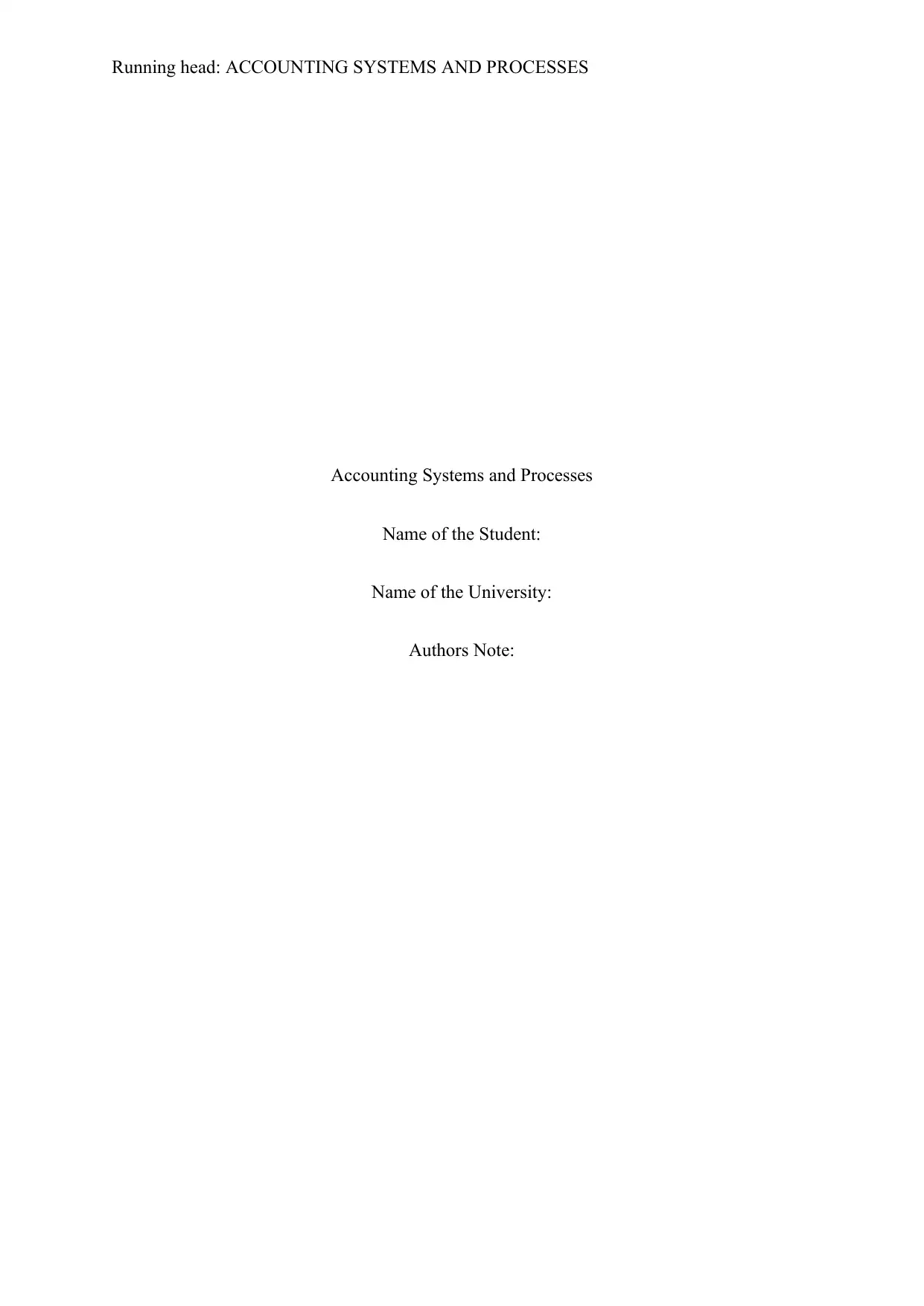
Running head: ACCOUNTING SYSTEMS AND PROCESSES
Accounting Systems and Processes
Name of the Student:
Name of the University:
Authors Note:
Accounting Systems and Processes
Name of the Student:
Name of the University:
Authors Note:
Secure Best Marks with AI Grader
Need help grading? Try our AI Grader for instant feedback on your assignments.
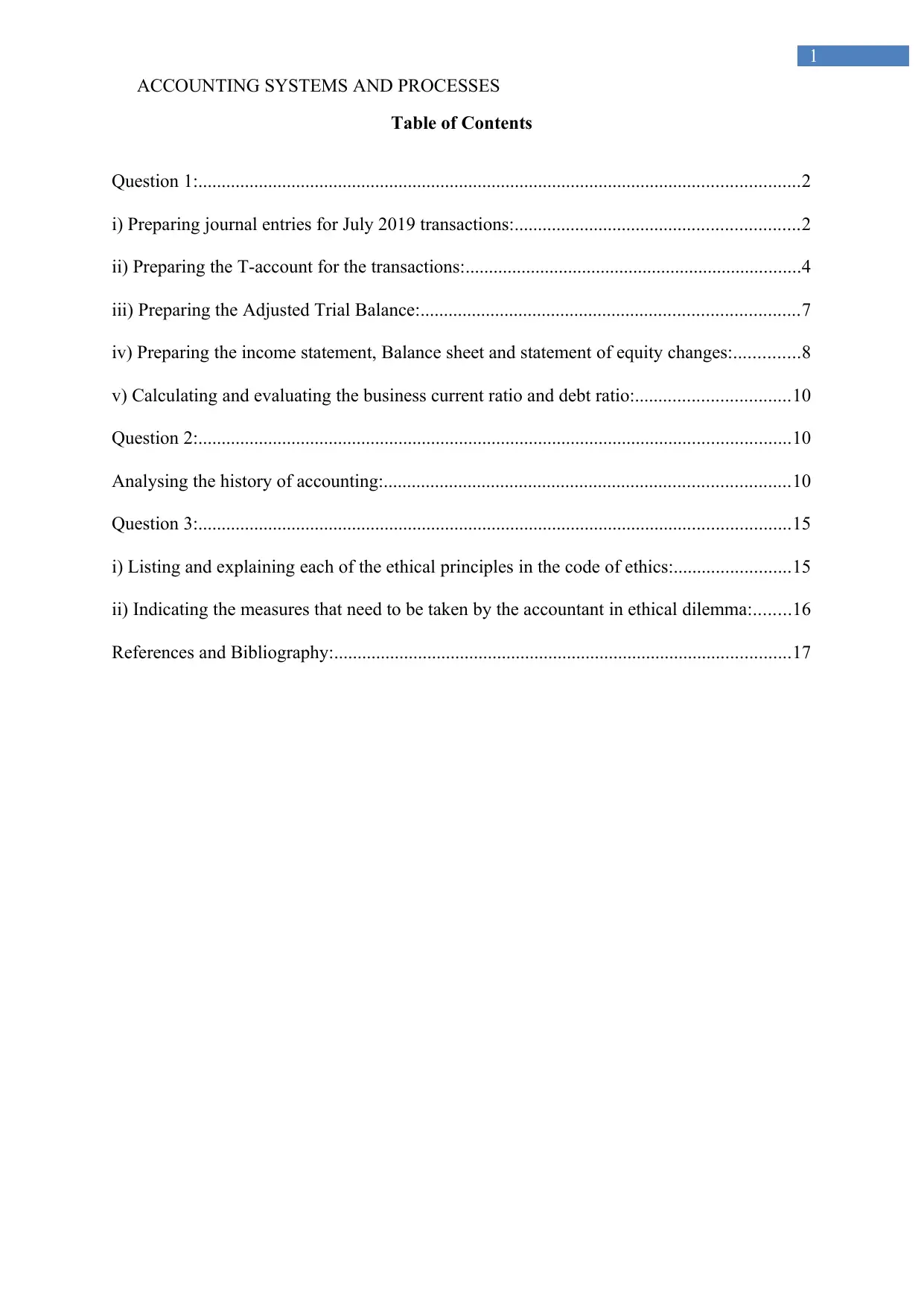
ACCOUNTING SYSTEMS AND PROCESSES
1
Table of Contents
Question 1:.................................................................................................................................2
i) Preparing journal entries for July 2019 transactions:.............................................................2
ii) Preparing the T-account for the transactions:........................................................................4
iii) Preparing the Adjusted Trial Balance:.................................................................................7
iv) Preparing the income statement, Balance sheet and statement of equity changes:..............8
v) Calculating and evaluating the business current ratio and debt ratio:.................................10
Question 2:...............................................................................................................................10
Analysing the history of accounting:.......................................................................................10
Question 3:...............................................................................................................................15
i) Listing and explaining each of the ethical principles in the code of ethics:.........................15
ii) Indicating the measures that need to be taken by the accountant in ethical dilemma:........16
References and Bibliography:..................................................................................................17
1
Table of Contents
Question 1:.................................................................................................................................2
i) Preparing journal entries for July 2019 transactions:.............................................................2
ii) Preparing the T-account for the transactions:........................................................................4
iii) Preparing the Adjusted Trial Balance:.................................................................................7
iv) Preparing the income statement, Balance sheet and statement of equity changes:..............8
v) Calculating and evaluating the business current ratio and debt ratio:.................................10
Question 2:...............................................................................................................................10
Analysing the history of accounting:.......................................................................................10
Question 3:...............................................................................................................................15
i) Listing and explaining each of the ethical principles in the code of ethics:.........................15
ii) Indicating the measures that need to be taken by the accountant in ethical dilemma:........16
References and Bibliography:..................................................................................................17
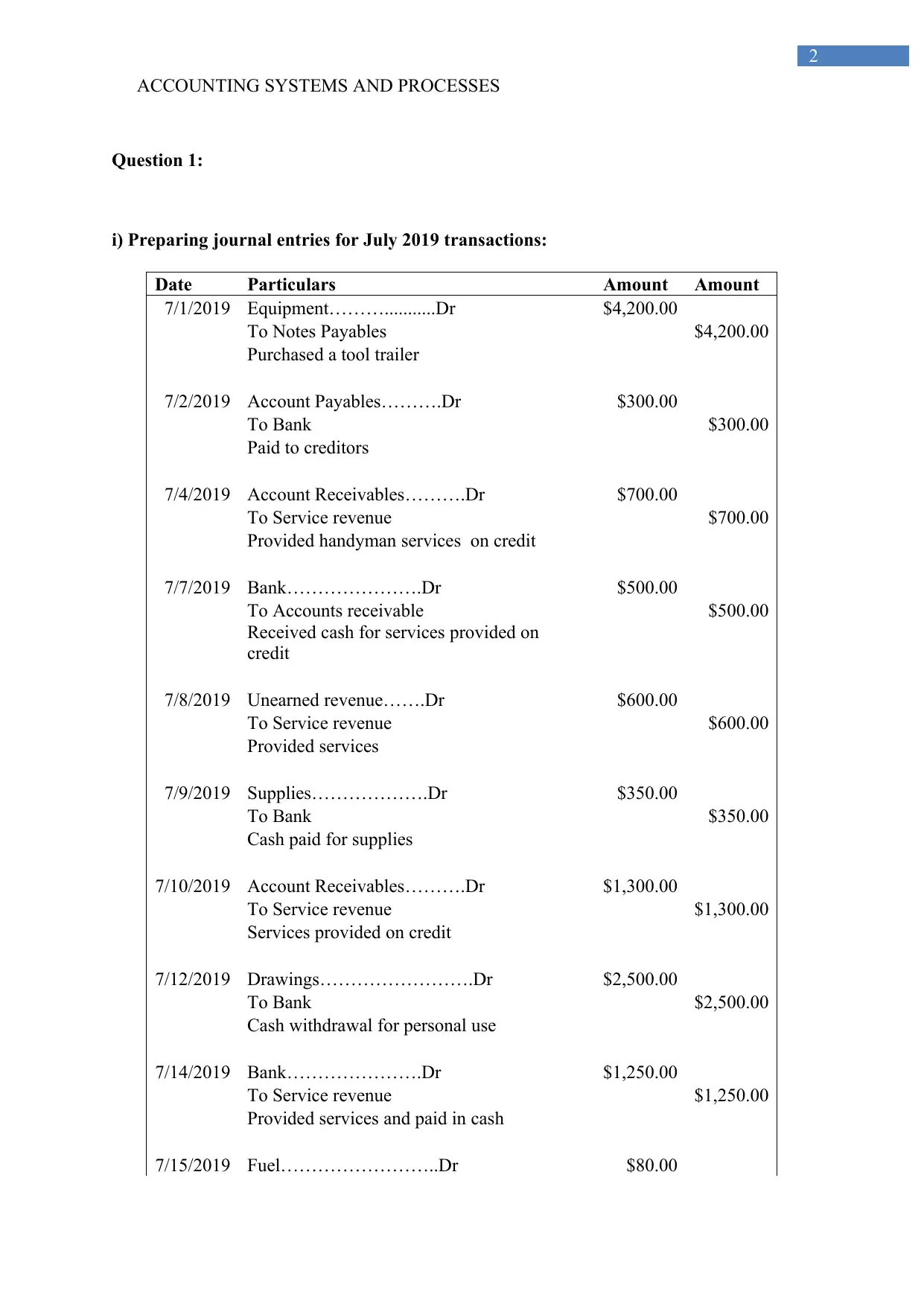
ACCOUNTING SYSTEMS AND PROCESSES
2
Question 1:
i) Preparing journal entries for July 2019 transactions:
Date Particulars Amount Amount
7/1/2019 Equipment………...........Dr $4,200.00
To Notes Payables $4,200.00
Purchased a tool trailer
7/2/2019 Account Payables……….Dr $300.00
To Bank $300.00
Paid to creditors
7/4/2019 Account Receivables……….Dr $700.00
To Service revenue $700.00
Provided handyman services on credit
7/7/2019 Bank………………….Dr $500.00
To Accounts receivable $500.00
Received cash for services provided on
credit
7/8/2019 Unearned revenue…….Dr $600.00
To Service revenue $600.00
Provided services
7/9/2019 Supplies……………….Dr $350.00
To Bank $350.00
Cash paid for supplies
7/10/2019 Account Receivables……….Dr $1,300.00
To Service revenue $1,300.00
Services provided on credit
7/12/2019 Drawings…………………….Dr $2,500.00
To Bank $2,500.00
Cash withdrawal for personal use
7/14/2019 Bank………………….Dr $1,250.00
To Service revenue $1,250.00
Provided services and paid in cash
7/15/2019 Fuel……………………..Dr $80.00
2
Question 1:
i) Preparing journal entries for July 2019 transactions:
Date Particulars Amount Amount
7/1/2019 Equipment………...........Dr $4,200.00
To Notes Payables $4,200.00
Purchased a tool trailer
7/2/2019 Account Payables……….Dr $300.00
To Bank $300.00
Paid to creditors
7/4/2019 Account Receivables……….Dr $700.00
To Service revenue $700.00
Provided handyman services on credit
7/7/2019 Bank………………….Dr $500.00
To Accounts receivable $500.00
Received cash for services provided on
credit
7/8/2019 Unearned revenue…….Dr $600.00
To Service revenue $600.00
Provided services
7/9/2019 Supplies……………….Dr $350.00
To Bank $350.00
Cash paid for supplies
7/10/2019 Account Receivables……….Dr $1,300.00
To Service revenue $1,300.00
Services provided on credit
7/12/2019 Drawings…………………….Dr $2,500.00
To Bank $2,500.00
Cash withdrawal for personal use
7/14/2019 Bank………………….Dr $1,250.00
To Service revenue $1,250.00
Provided services and paid in cash
7/15/2019 Fuel……………………..Dr $80.00
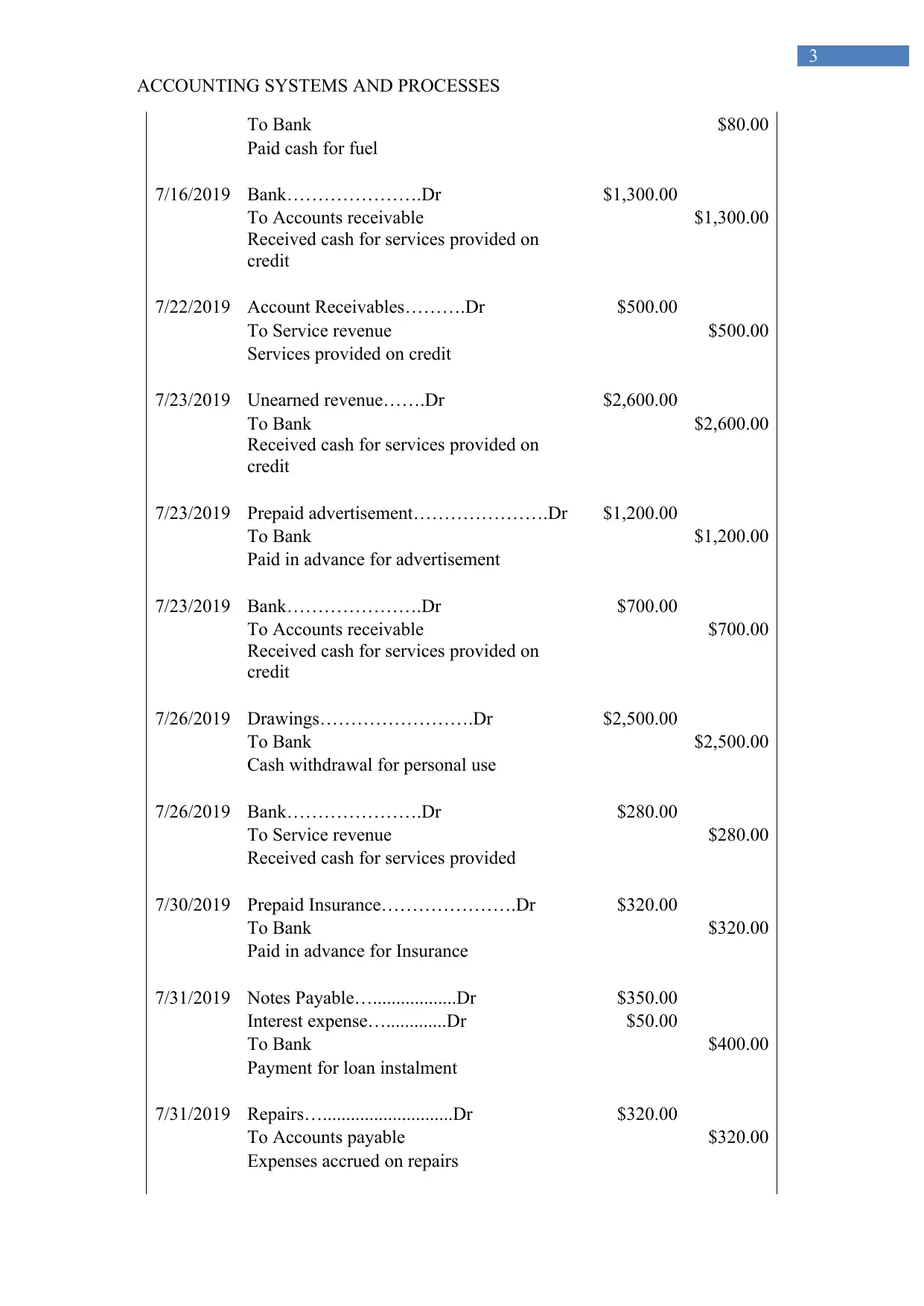
ACCOUNTING SYSTEMS AND PROCESSES
3
To Bank $80.00
Paid cash for fuel
7/16/2019 Bank………………….Dr $1,300.00
To Accounts receivable $1,300.00
Received cash for services provided on
credit
7/22/2019 Account Receivables……….Dr $500.00
To Service revenue $500.00
Services provided on credit
7/23/2019 Unearned revenue…….Dr $2,600.00
To Bank $2,600.00
Received cash for services provided on
credit
7/23/2019 Prepaid advertisement………………….Dr $1,200.00
To Bank $1,200.00
Paid in advance for advertisement
7/23/2019 Bank………………….Dr $700.00
To Accounts receivable $700.00
Received cash for services provided on
credit
7/26/2019 Drawings…………………….Dr $2,500.00
To Bank $2,500.00
Cash withdrawal for personal use
7/26/2019 Bank………………….Dr $280.00
To Service revenue $280.00
Received cash for services provided
7/30/2019 Prepaid Insurance………………….Dr $320.00
To Bank $320.00
Paid in advance for Insurance
7/31/2019 Notes Payable…..................Dr $350.00
Interest expense….............Dr $50.00
To Bank $400.00
Payment for loan instalment
7/31/2019 Repairs…............................Dr $320.00
To Accounts payable $320.00
Expenses accrued on repairs
3
To Bank $80.00
Paid cash for fuel
7/16/2019 Bank………………….Dr $1,300.00
To Accounts receivable $1,300.00
Received cash for services provided on
credit
7/22/2019 Account Receivables……….Dr $500.00
To Service revenue $500.00
Services provided on credit
7/23/2019 Unearned revenue…….Dr $2,600.00
To Bank $2,600.00
Received cash for services provided on
credit
7/23/2019 Prepaid advertisement………………….Dr $1,200.00
To Bank $1,200.00
Paid in advance for advertisement
7/23/2019 Bank………………….Dr $700.00
To Accounts receivable $700.00
Received cash for services provided on
credit
7/26/2019 Drawings…………………….Dr $2,500.00
To Bank $2,500.00
Cash withdrawal for personal use
7/26/2019 Bank………………….Dr $280.00
To Service revenue $280.00
Received cash for services provided
7/30/2019 Prepaid Insurance………………….Dr $320.00
To Bank $320.00
Paid in advance for Insurance
7/31/2019 Notes Payable…..................Dr $350.00
Interest expense….............Dr $50.00
To Bank $400.00
Payment for loan instalment
7/31/2019 Repairs…............................Dr $320.00
To Accounts payable $320.00
Expenses accrued on repairs
Secure Best Marks with AI Grader
Need help grading? Try our AI Grader for instant feedback on your assignments.
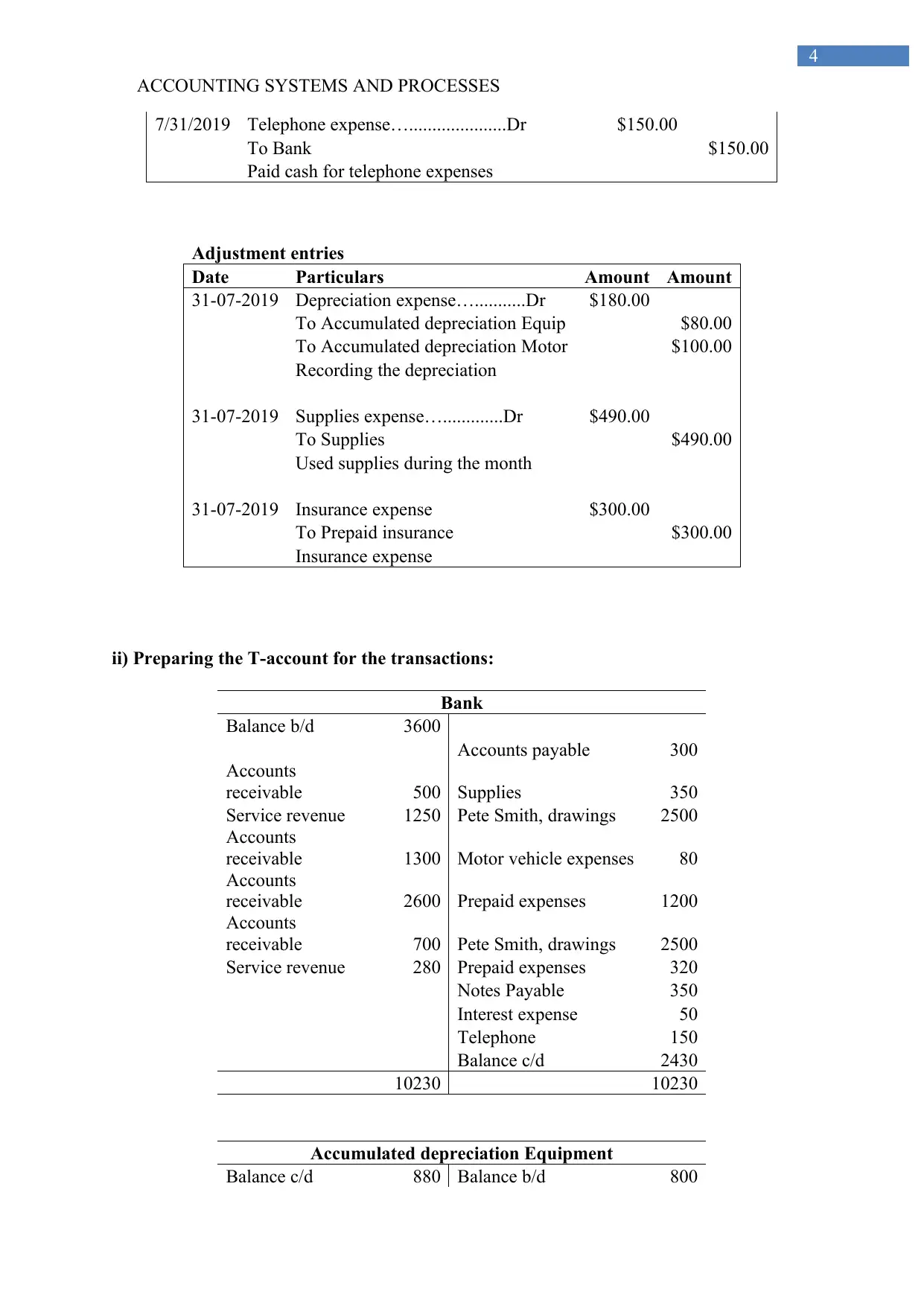
ACCOUNTING SYSTEMS AND PROCESSES
4
7/31/2019 Telephone expense….....................Dr $150.00
To Bank $150.00
Paid cash for telephone expenses
Adjustment entries
Date Particulars Amount Amount
31-07-2019 Depreciation expense…...........Dr $180.00
To Accumulated depreciation Equip $80.00
To Accumulated depreciation Motor $100.00
Recording the depreciation
31-07-2019 Supplies expense….............Dr $490.00
To Supplies $490.00
Used supplies during the month
31-07-2019 Insurance expense $300.00
To Prepaid insurance $300.00
Insurance expense
ii) Preparing the T-account for the transactions:
Bank
Balance b/d 3600
Accounts payable 300
Accounts
receivable 500 Supplies 350
Service revenue 1250 Pete Smith, drawings 2500
Accounts
receivable 1300 Motor vehicle expenses 80
Accounts
receivable 2600 Prepaid expenses 1200
Accounts
receivable 700 Pete Smith, drawings 2500
Service revenue 280 Prepaid expenses 320
Notes Payable 350
Interest expense 50
Telephone 150
Balance c/d 2430
10230 10230
Accumulated depreciation Equipment
Balance c/d 880 Balance b/d 800
4
7/31/2019 Telephone expense….....................Dr $150.00
To Bank $150.00
Paid cash for telephone expenses
Adjustment entries
Date Particulars Amount Amount
31-07-2019 Depreciation expense…...........Dr $180.00
To Accumulated depreciation Equip $80.00
To Accumulated depreciation Motor $100.00
Recording the depreciation
31-07-2019 Supplies expense….............Dr $490.00
To Supplies $490.00
Used supplies during the month
31-07-2019 Insurance expense $300.00
To Prepaid insurance $300.00
Insurance expense
ii) Preparing the T-account for the transactions:
Bank
Balance b/d 3600
Accounts payable 300
Accounts
receivable 500 Supplies 350
Service revenue 1250 Pete Smith, drawings 2500
Accounts
receivable 1300 Motor vehicle expenses 80
Accounts
receivable 2600 Prepaid expenses 1200
Accounts
receivable 700 Pete Smith, drawings 2500
Service revenue 280 Prepaid expenses 320
Notes Payable 350
Interest expense 50
Telephone 150
Balance c/d 2430
10230 10230
Accumulated depreciation Equipment
Balance c/d 880 Balance b/d 800
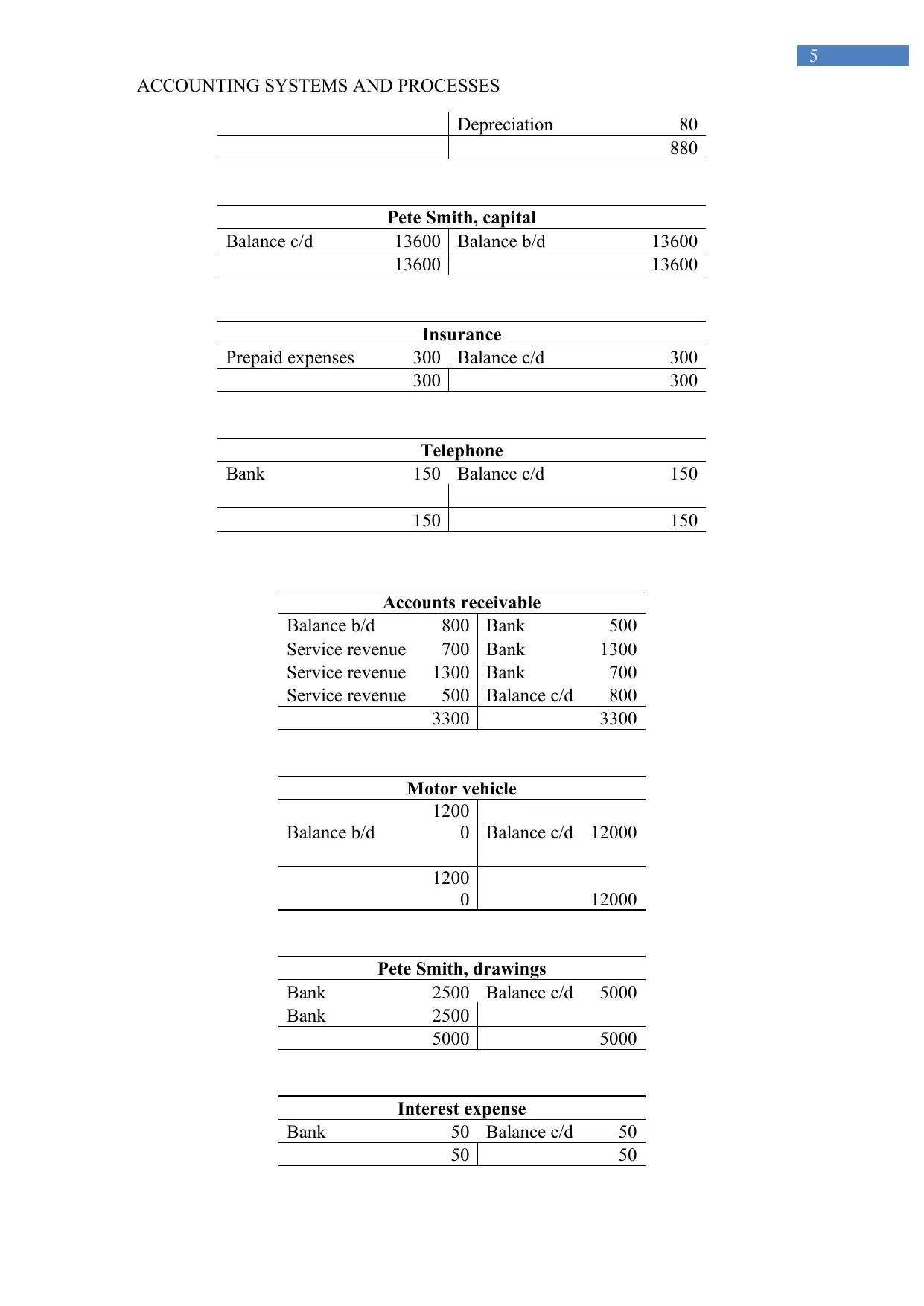
ACCOUNTING SYSTEMS AND PROCESSES
5
Depreciation 80
880
Pete Smith, capital
Balance c/d 13600 Balance b/d 13600
13600 13600
Insurance
Prepaid expenses 300 Balance c/d 300
300 300
Telephone
Bank 150 Balance c/d 150
150 150
Accounts receivable
Balance b/d 800 Bank 500
Service revenue 700 Bank 1300
Service revenue 1300 Bank 700
Service revenue 500 Balance c/d 800
3300 3300
Motor vehicle
Balance b/d
1200
0 Balance c/d 12000
1200
0 12000
Pete Smith, drawings
Bank 2500 Balance c/d 5000
Bank 2500
5000 5000
Interest expense
Bank 50 Balance c/d 50
50 50
5
Depreciation 80
880
Pete Smith, capital
Balance c/d 13600 Balance b/d 13600
13600 13600
Insurance
Prepaid expenses 300 Balance c/d 300
300 300
Telephone
Bank 150 Balance c/d 150
150 150
Accounts receivable
Balance b/d 800 Bank 500
Service revenue 700 Bank 1300
Service revenue 1300 Bank 700
Service revenue 500 Balance c/d 800
3300 3300
Motor vehicle
Balance b/d
1200
0 Balance c/d 12000
1200
0 12000
Pete Smith, drawings
Bank 2500 Balance c/d 5000
Bank 2500
5000 5000
Interest expense
Bank 50 Balance c/d 50
50 50
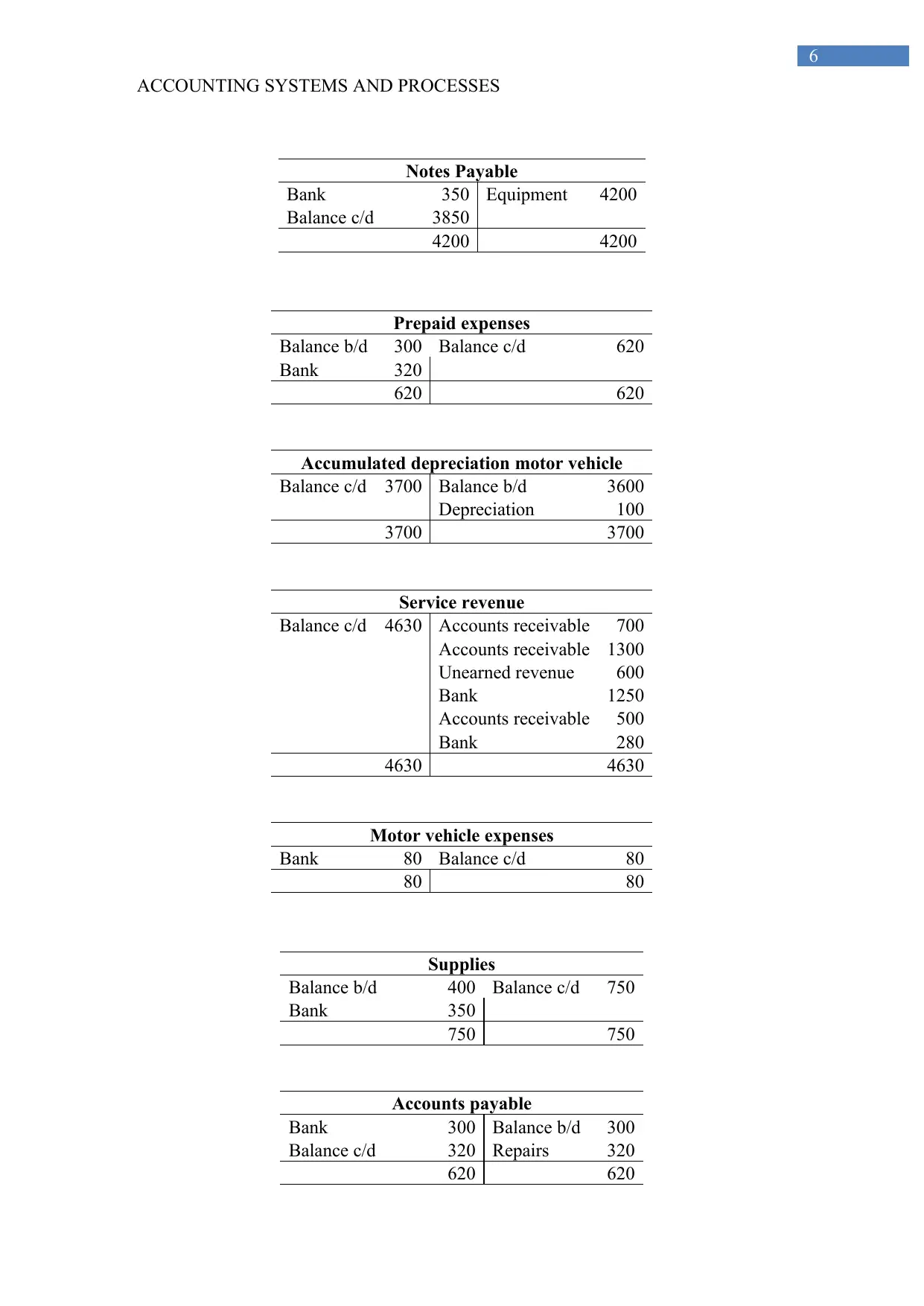
ACCOUNTING SYSTEMS AND PROCESSES
6
Notes Payable
Bank 350 Equipment 4200
Balance c/d 3850
4200 4200
Prepaid expenses
Balance b/d 300 Balance c/d 620
Bank 320
620 620
Accumulated depreciation motor vehicle
Balance c/d 3700 Balance b/d 3600
Depreciation 100
3700 3700
Service revenue
Balance c/d 4630 Accounts receivable 700
Accounts receivable 1300
Unearned revenue 600
Bank 1250
Accounts receivable 500
Bank 280
4630 4630
Motor vehicle expenses
Bank 80 Balance c/d 80
80 80
Supplies
Balance b/d 400 Balance c/d 750
Bank 350
750 750
Accounts payable
Bank 300 Balance b/d 300
Balance c/d 320 Repairs 320
620 620
6
Notes Payable
Bank 350 Equipment 4200
Balance c/d 3850
4200 4200
Prepaid expenses
Balance b/d 300 Balance c/d 620
Bank 320
620 620
Accumulated depreciation motor vehicle
Balance c/d 3700 Balance b/d 3600
Depreciation 100
3700 3700
Service revenue
Balance c/d 4630 Accounts receivable 700
Accounts receivable 1300
Unearned revenue 600
Bank 1250
Accounts receivable 500
Bank 280
4630 4630
Motor vehicle expenses
Bank 80 Balance c/d 80
80 80
Supplies
Balance b/d 400 Balance c/d 750
Bank 350
750 750
Accounts payable
Bank 300 Balance b/d 300
Balance c/d 320 Repairs 320
620 620
Paraphrase This Document
Need a fresh take? Get an instant paraphrase of this document with our AI Paraphraser
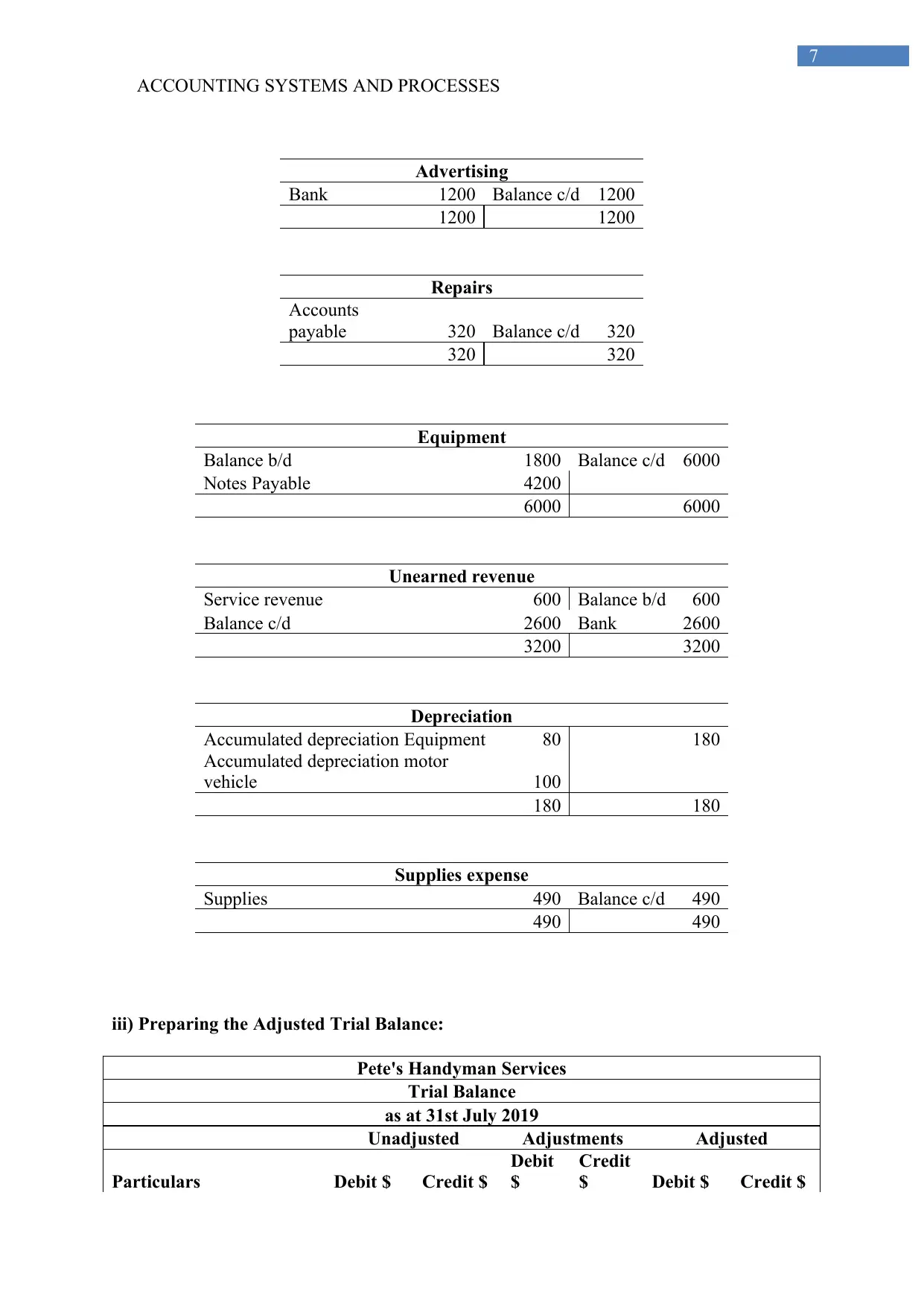
ACCOUNTING SYSTEMS AND PROCESSES
7
Advertising
Bank 1200 Balance c/d 1200
1200 1200
Repairs
Accounts
payable 320 Balance c/d 320
320 320
Equipment
Balance b/d 1800 Balance c/d 6000
Notes Payable 4200
6000 6000
Unearned revenue
Service revenue 600 Balance b/d 600
Balance c/d 2600 Bank 2600
3200 3200
Depreciation
Accumulated depreciation Equipment 80 180
Accumulated depreciation motor
vehicle 100
180 180
Supplies expense
Supplies 490 Balance c/d 490
490 490
iii) Preparing the Adjusted Trial Balance:
Pete's Handyman Services
Trial Balance
as at 31st July 2019
Unadjusted Adjustments Adjusted
Particulars Debit $ Credit $
Debit
$
Credit
$ Debit $ Credit $
7
Advertising
Bank 1200 Balance c/d 1200
1200 1200
Repairs
Accounts
payable 320 Balance c/d 320
320 320
Equipment
Balance b/d 1800 Balance c/d 6000
Notes Payable 4200
6000 6000
Unearned revenue
Service revenue 600 Balance b/d 600
Balance c/d 2600 Bank 2600
3200 3200
Depreciation
Accumulated depreciation Equipment 80 180
Accumulated depreciation motor
vehicle 100
180 180
Supplies expense
Supplies 490 Balance c/d 490
490 490
iii) Preparing the Adjusted Trial Balance:
Pete's Handyman Services
Trial Balance
as at 31st July 2019
Unadjusted Adjustments Adjusted
Particulars Debit $ Credit $
Debit
$
Credit
$ Debit $ Credit $
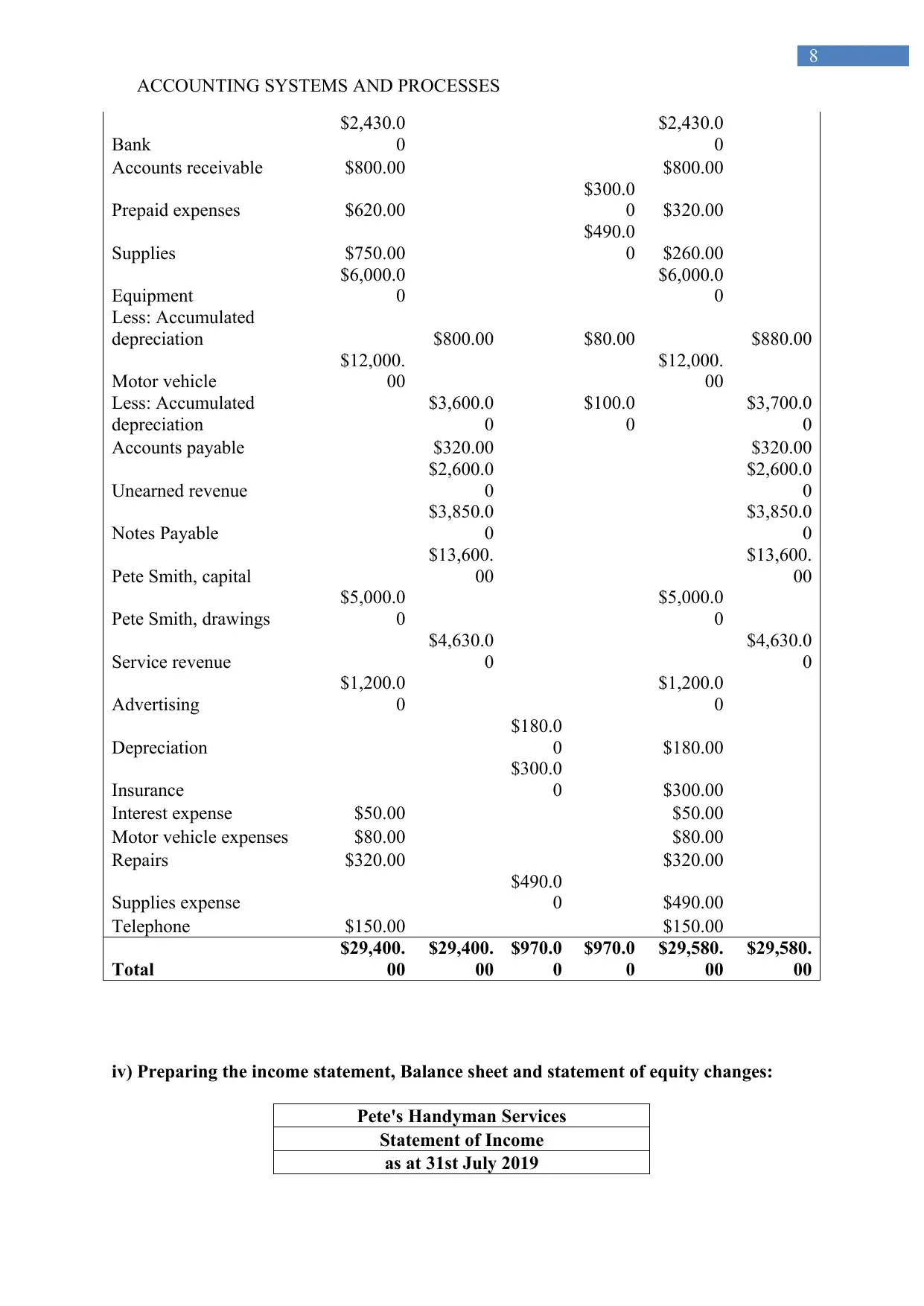
ACCOUNTING SYSTEMS AND PROCESSES
8
Bank
$2,430.0
0
$2,430.0
0
Accounts receivable $800.00 $800.00
Prepaid expenses $620.00
$300.0
0 $320.00
Supplies $750.00
$490.0
0 $260.00
Equipment
$6,000.0
0
$6,000.0
0
Less: Accumulated
depreciation $800.00 $80.00 $880.00
Motor vehicle
$12,000.
00
$12,000.
00
Less: Accumulated
depreciation
$3,600.0
0
$100.0
0
$3,700.0
0
Accounts payable $320.00 $320.00
Unearned revenue
$2,600.0
0
$2,600.0
0
Notes Payable
$3,850.0
0
$3,850.0
0
Pete Smith, capital
$13,600.
00
$13,600.
00
Pete Smith, drawings
$5,000.0
0
$5,000.0
0
Service revenue
$4,630.0
0
$4,630.0
0
Advertising
$1,200.0
0
$1,200.0
0
Depreciation
$180.0
0 $180.00
Insurance
$300.0
0 $300.00
Interest expense $50.00 $50.00
Motor vehicle expenses $80.00 $80.00
Repairs $320.00 $320.00
Supplies expense
$490.0
0 $490.00
Telephone $150.00 $150.00
Total
$29,400.
00
$29,400.
00
$970.0
0
$970.0
0
$29,580.
00
$29,580.
00
iv) Preparing the income statement, Balance sheet and statement of equity changes:
Pete's Handyman Services
Statement of Income
as at 31st July 2019
8
Bank
$2,430.0
0
$2,430.0
0
Accounts receivable $800.00 $800.00
Prepaid expenses $620.00
$300.0
0 $320.00
Supplies $750.00
$490.0
0 $260.00
Equipment
$6,000.0
0
$6,000.0
0
Less: Accumulated
depreciation $800.00 $80.00 $880.00
Motor vehicle
$12,000.
00
$12,000.
00
Less: Accumulated
depreciation
$3,600.0
0
$100.0
0
$3,700.0
0
Accounts payable $320.00 $320.00
Unearned revenue
$2,600.0
0
$2,600.0
0
Notes Payable
$3,850.0
0
$3,850.0
0
Pete Smith, capital
$13,600.
00
$13,600.
00
Pete Smith, drawings
$5,000.0
0
$5,000.0
0
Service revenue
$4,630.0
0
$4,630.0
0
Advertising
$1,200.0
0
$1,200.0
0
Depreciation
$180.0
0 $180.00
Insurance
$300.0
0 $300.00
Interest expense $50.00 $50.00
Motor vehicle expenses $80.00 $80.00
Repairs $320.00 $320.00
Supplies expense
$490.0
0 $490.00
Telephone $150.00 $150.00
Total
$29,400.
00
$29,400.
00
$970.0
0
$970.0
0
$29,580.
00
$29,580.
00
iv) Preparing the income statement, Balance sheet and statement of equity changes:
Pete's Handyman Services
Statement of Income
as at 31st July 2019
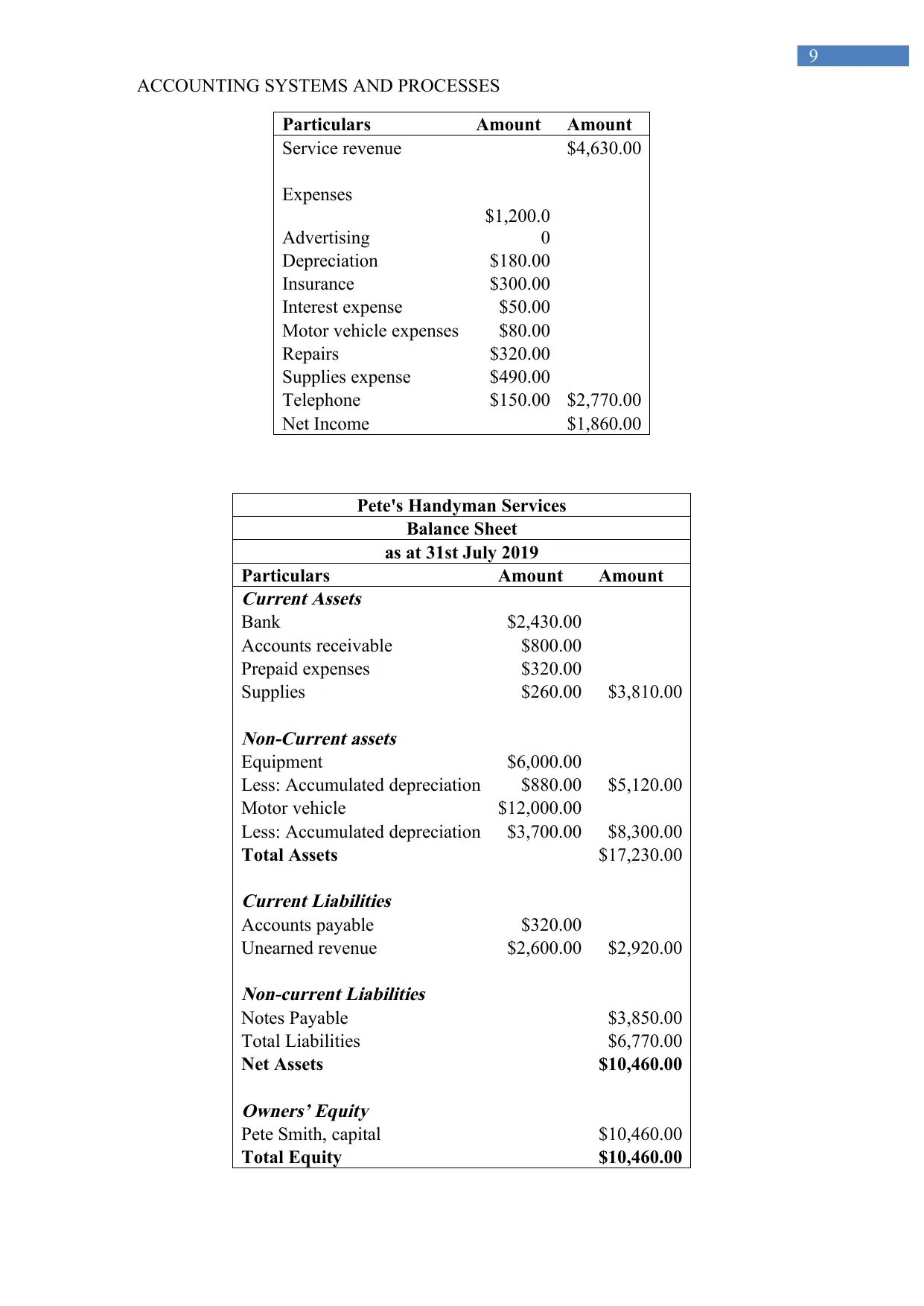
ACCOUNTING SYSTEMS AND PROCESSES
9
Particulars Amount Amount
Service revenue $4,630.00
Expenses
Advertising
$1,200.0
0
Depreciation $180.00
Insurance $300.00
Interest expense $50.00
Motor vehicle expenses $80.00
Repairs $320.00
Supplies expense $490.00
Telephone $150.00 $2,770.00
Net Income $1,860.00
Pete's Handyman Services
Balance Sheet
as at 31st July 2019
Particulars Amount Amount
Current Assets
Bank $2,430.00
Accounts receivable $800.00
Prepaid expenses $320.00
Supplies $260.00 $3,810.00
Non-Current assets
Equipment $6,000.00
Less: Accumulated depreciation $880.00 $5,120.00
Motor vehicle $12,000.00
Less: Accumulated depreciation $3,700.00 $8,300.00
Total Assets $17,230.00
Current Liabilities
Accounts payable $320.00
Unearned revenue $2,600.00 $2,920.00
Non-current Liabilities
Notes Payable $3,850.00
Total Liabilities $6,770.00
Net Assets $10,460.00
Owners’ Equity
Pete Smith, capital $10,460.00
Total Equity $10,460.00
9
Particulars Amount Amount
Service revenue $4,630.00
Expenses
Advertising
$1,200.0
0
Depreciation $180.00
Insurance $300.00
Interest expense $50.00
Motor vehicle expenses $80.00
Repairs $320.00
Supplies expense $490.00
Telephone $150.00 $2,770.00
Net Income $1,860.00
Pete's Handyman Services
Balance Sheet
as at 31st July 2019
Particulars Amount Amount
Current Assets
Bank $2,430.00
Accounts receivable $800.00
Prepaid expenses $320.00
Supplies $260.00 $3,810.00
Non-Current assets
Equipment $6,000.00
Less: Accumulated depreciation $880.00 $5,120.00
Motor vehicle $12,000.00
Less: Accumulated depreciation $3,700.00 $8,300.00
Total Assets $17,230.00
Current Liabilities
Accounts payable $320.00
Unearned revenue $2,600.00 $2,920.00
Non-current Liabilities
Notes Payable $3,850.00
Total Liabilities $6,770.00
Net Assets $10,460.00
Owners’ Equity
Pete Smith, capital $10,460.00
Total Equity $10,460.00
Secure Best Marks with AI Grader
Need help grading? Try our AI Grader for instant feedback on your assignments.
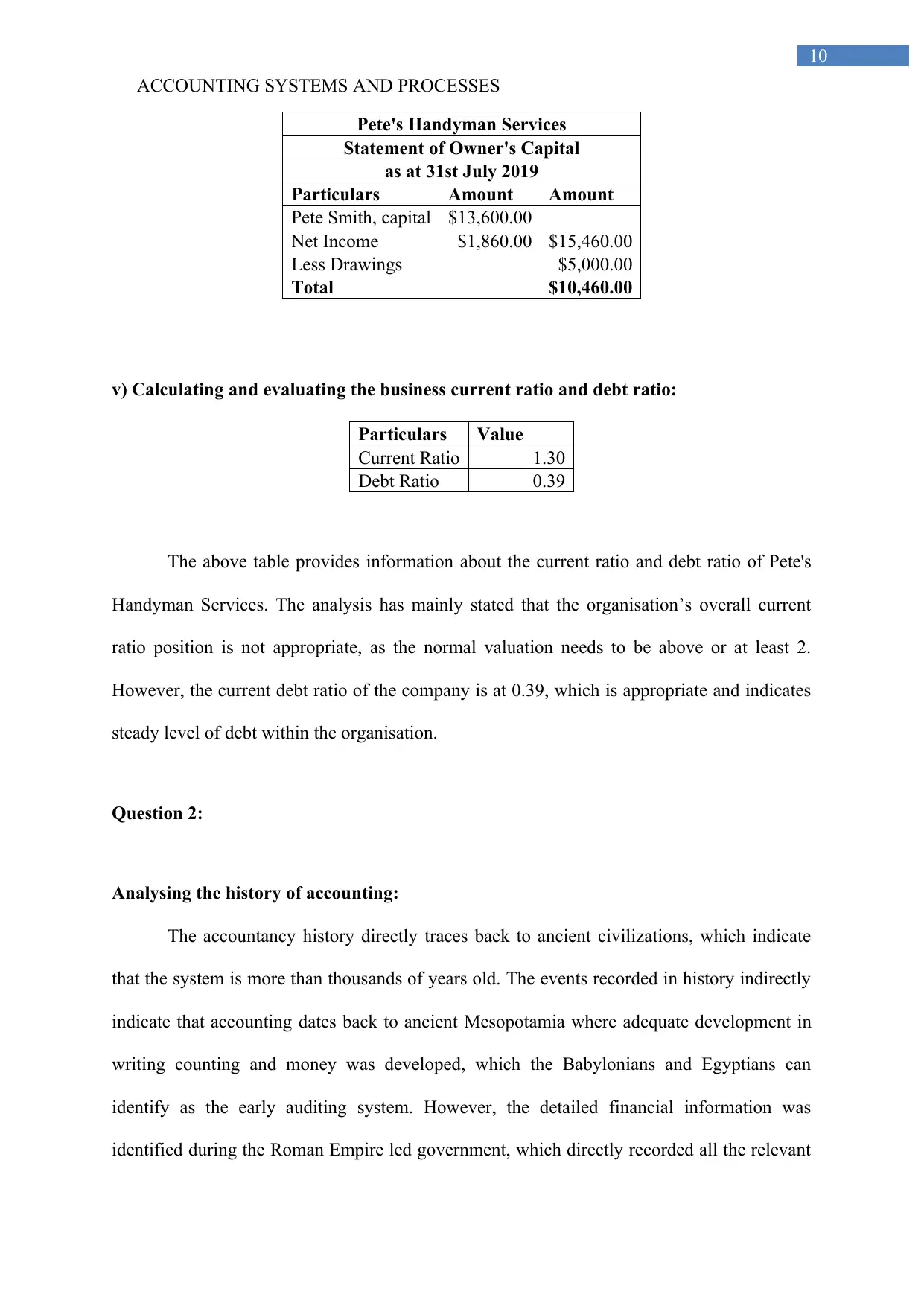
ACCOUNTING SYSTEMS AND PROCESSES
10
Pete's Handyman Services
Statement of Owner's Capital
as at 31st July 2019
Particulars Amount Amount
Pete Smith, capital $13,600.00
Net Income $1,860.00 $15,460.00
Less Drawings $5,000.00
Total $10,460.00
v) Calculating and evaluating the business current ratio and debt ratio:
Particulars Value
Current Ratio 1.30
Debt Ratio 0.39
The above table provides information about the current ratio and debt ratio of Pete's
Handyman Services. The analysis has mainly stated that the organisation’s overall current
ratio position is not appropriate, as the normal valuation needs to be above or at least 2.
However, the current debt ratio of the company is at 0.39, which is appropriate and indicates
steady level of debt within the organisation.
Question 2:
Analysing the history of accounting:
The accountancy history directly traces back to ancient civilizations, which indicate
that the system is more than thousands of years old. The events recorded in history indirectly
indicate that accounting dates back to ancient Mesopotamia where adequate development in
writing counting and money was developed, which the Babylonians and Egyptians can
identify as the early auditing system. However, the detailed financial information was
identified during the Roman Empire led government, which directly recorded all the relevant
10
Pete's Handyman Services
Statement of Owner's Capital
as at 31st July 2019
Particulars Amount Amount
Pete Smith, capital $13,600.00
Net Income $1,860.00 $15,460.00
Less Drawings $5,000.00
Total $10,460.00
v) Calculating and evaluating the business current ratio and debt ratio:
Particulars Value
Current Ratio 1.30
Debt Ratio 0.39
The above table provides information about the current ratio and debt ratio of Pete's
Handyman Services. The analysis has mainly stated that the organisation’s overall current
ratio position is not appropriate, as the normal valuation needs to be above or at least 2.
However, the current debt ratio of the company is at 0.39, which is appropriate and indicates
steady level of debt within the organisation.
Question 2:
Analysing the history of accounting:
The accountancy history directly traces back to ancient civilizations, which indicate
that the system is more than thousands of years old. The events recorded in history indirectly
indicate that accounting dates back to ancient Mesopotamia where adequate development in
writing counting and money was developed, which the Babylonians and Egyptians can
identify as the early auditing system. However, the detailed financial information was
identified during the Roman Empire led government, which directly recorded all the relevant
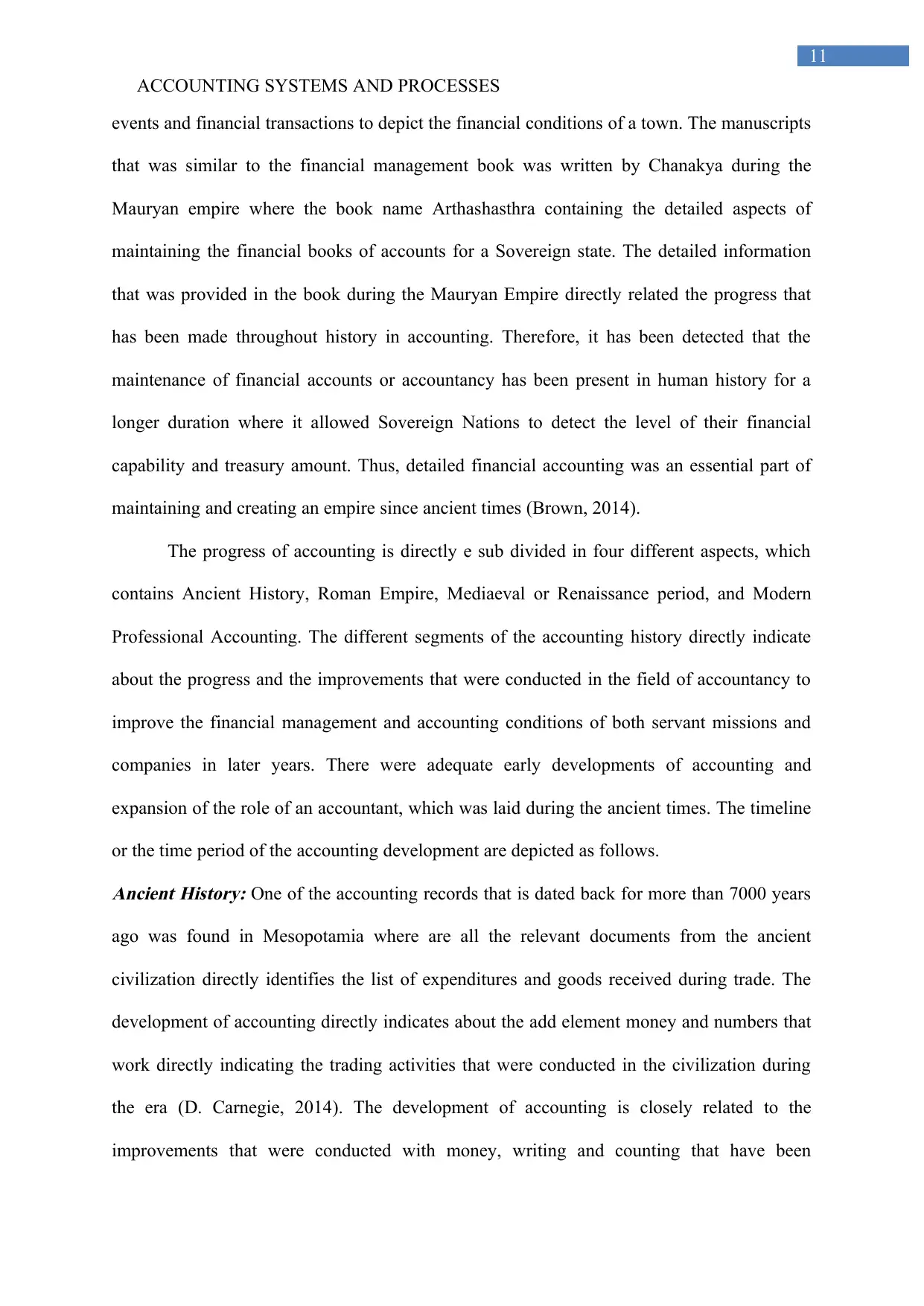
ACCOUNTING SYSTEMS AND PROCESSES
11
events and financial transactions to depict the financial conditions of a town. The manuscripts
that was similar to the financial management book was written by Chanakya during the
Mauryan empire where the book name Arthashasthra containing the detailed aspects of
maintaining the financial books of accounts for a Sovereign state. The detailed information
that was provided in the book during the Mauryan Empire directly related the progress that
has been made throughout history in accounting. Therefore, it has been detected that the
maintenance of financial accounts or accountancy has been present in human history for a
longer duration where it allowed Sovereign Nations to detect the level of their financial
capability and treasury amount. Thus, detailed financial accounting was an essential part of
maintaining and creating an empire since ancient times (Brown, 2014).
The progress of accounting is directly e sub divided in four different aspects, which
contains Ancient History, Roman Empire, Mediaeval or Renaissance period, and Modern
Professional Accounting. The different segments of the accounting history directly indicate
about the progress and the improvements that were conducted in the field of accountancy to
improve the financial management and accounting conditions of both servant missions and
companies in later years. There were adequate early developments of accounting and
expansion of the role of an accountant, which was laid during the ancient times. The timeline
or the time period of the accounting development are depicted as follows.
Ancient History: One of the accounting records that is dated back for more than 7000 years
ago was found in Mesopotamia where are all the relevant documents from the ancient
civilization directly identifies the list of expenditures and goods received during trade. The
development of accounting directly indicates about the add element money and numbers that
work directly indicating the trading activities that were conducted in the civilization during
the era (D. Carnegie, 2014). The development of accounting is closely related to the
improvements that were conducted with money, writing and counting that have been
11
events and financial transactions to depict the financial conditions of a town. The manuscripts
that was similar to the financial management book was written by Chanakya during the
Mauryan empire where the book name Arthashasthra containing the detailed aspects of
maintaining the financial books of accounts for a Sovereign state. The detailed information
that was provided in the book during the Mauryan Empire directly related the progress that
has been made throughout history in accounting. Therefore, it has been detected that the
maintenance of financial accounts or accountancy has been present in human history for a
longer duration where it allowed Sovereign Nations to detect the level of their financial
capability and treasury amount. Thus, detailed financial accounting was an essential part of
maintaining and creating an empire since ancient times (Brown, 2014).
The progress of accounting is directly e sub divided in four different aspects, which
contains Ancient History, Roman Empire, Mediaeval or Renaissance period, and Modern
Professional Accounting. The different segments of the accounting history directly indicate
about the progress and the improvements that were conducted in the field of accountancy to
improve the financial management and accounting conditions of both servant missions and
companies in later years. There were adequate early developments of accounting and
expansion of the role of an accountant, which was laid during the ancient times. The timeline
or the time period of the accounting development are depicted as follows.
Ancient History: One of the accounting records that is dated back for more than 7000 years
ago was found in Mesopotamia where are all the relevant documents from the ancient
civilization directly identifies the list of expenditures and goods received during trade. The
development of accounting directly indicates about the add element money and numbers that
work directly indicating the trading activities that were conducted in the civilization during
the era (D. Carnegie, 2014). The development of accounting is closely related to the
improvements that were conducted with money, writing and counting that have been
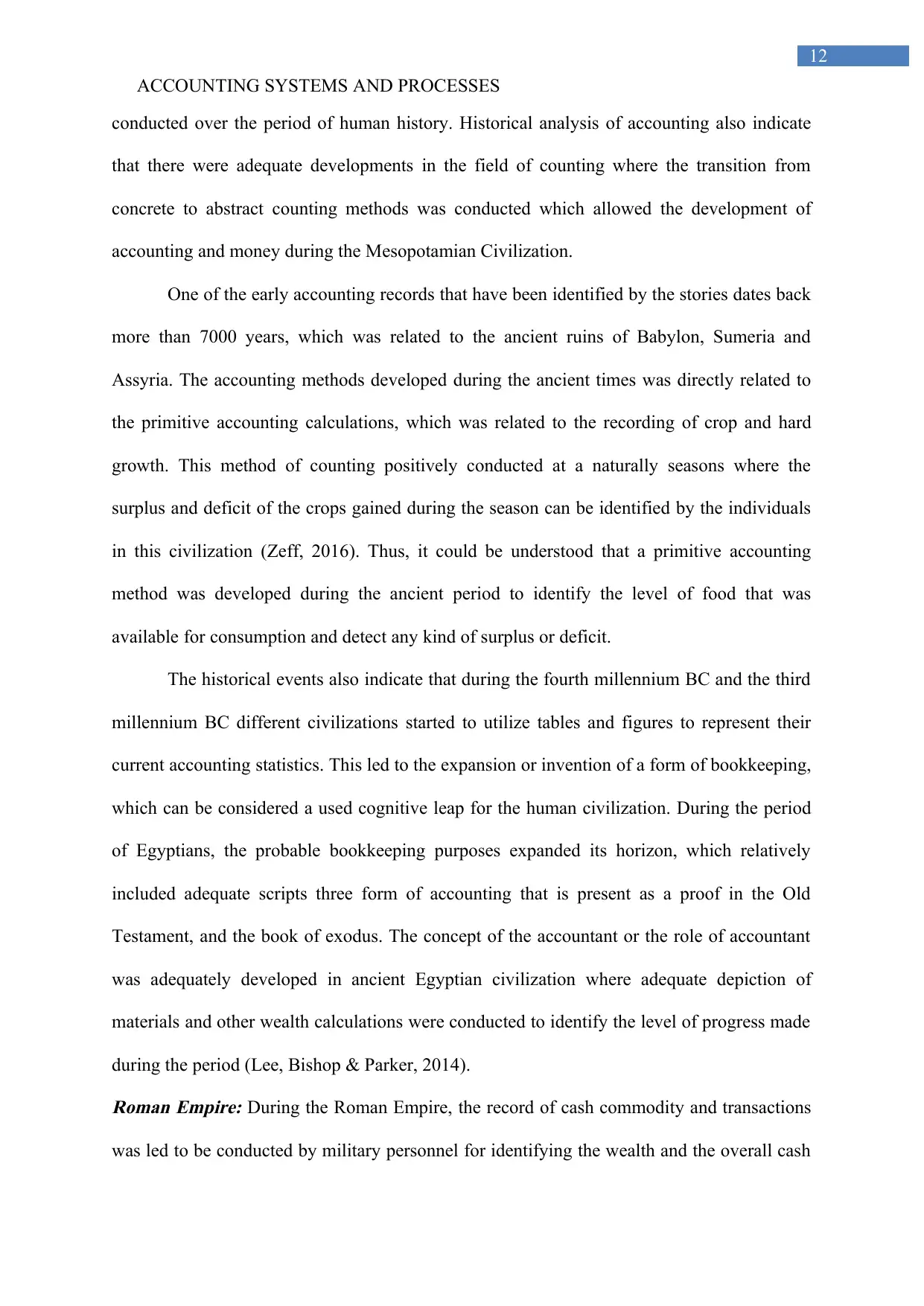
ACCOUNTING SYSTEMS AND PROCESSES
12
conducted over the period of human history. Historical analysis of accounting also indicate
that there were adequate developments in the field of counting where the transition from
concrete to abstract counting methods was conducted which allowed the development of
accounting and money during the Mesopotamian Civilization.
One of the early accounting records that have been identified by the stories dates back
more than 7000 years, which was related to the ancient ruins of Babylon, Sumeria and
Assyria. The accounting methods developed during the ancient times was directly related to
the primitive accounting calculations, which was related to the recording of crop and hard
growth. This method of counting positively conducted at a naturally seasons where the
surplus and deficit of the crops gained during the season can be identified by the individuals
in this civilization (Zeff, 2016). Thus, it could be understood that a primitive accounting
method was developed during the ancient period to identify the level of food that was
available for consumption and detect any kind of surplus or deficit.
The historical events also indicate that during the fourth millennium BC and the third
millennium BC different civilizations started to utilize tables and figures to represent their
current accounting statistics. This led to the expansion or invention of a form of bookkeeping,
which can be considered a used cognitive leap for the human civilization. During the period
of Egyptians, the probable bookkeeping purposes expanded its horizon, which relatively
included adequate scripts three form of accounting that is present as a proof in the Old
Testament, and the book of exodus. The concept of the accountant or the role of accountant
was adequately developed in ancient Egyptian civilization where adequate depiction of
materials and other wealth calculations were conducted to identify the level of progress made
during the period (Lee, Bishop & Parker, 2014).
Roman Empire: During the Roman Empire, the record of cash commodity and transactions
was led to be conducted by military personnel for identifying the wealth and the overall cash
12
conducted over the period of human history. Historical analysis of accounting also indicate
that there were adequate developments in the field of counting where the transition from
concrete to abstract counting methods was conducted which allowed the development of
accounting and money during the Mesopotamian Civilization.
One of the early accounting records that have been identified by the stories dates back
more than 7000 years, which was related to the ancient ruins of Babylon, Sumeria and
Assyria. The accounting methods developed during the ancient times was directly related to
the primitive accounting calculations, which was related to the recording of crop and hard
growth. This method of counting positively conducted at a naturally seasons where the
surplus and deficit of the crops gained during the season can be identified by the individuals
in this civilization (Zeff, 2016). Thus, it could be understood that a primitive accounting
method was developed during the ancient period to identify the level of food that was
available for consumption and detect any kind of surplus or deficit.
The historical events also indicate that during the fourth millennium BC and the third
millennium BC different civilizations started to utilize tables and figures to represent their
current accounting statistics. This led to the expansion or invention of a form of bookkeeping,
which can be considered a used cognitive leap for the human civilization. During the period
of Egyptians, the probable bookkeeping purposes expanded its horizon, which relatively
included adequate scripts three form of accounting that is present as a proof in the Old
Testament, and the book of exodus. The concept of the accountant or the role of accountant
was adequately developed in ancient Egyptian civilization where adequate depiction of
materials and other wealth calculations were conducted to identify the level of progress made
during the period (Lee, Bishop & Parker, 2014).
Roman Empire: During the Roman Empire, the record of cash commodity and transactions
was led to be conducted by military personnel for identifying the wealth and the overall cash
Paraphrase This Document
Need a fresh take? Get an instant paraphrase of this document with our AI Paraphraser
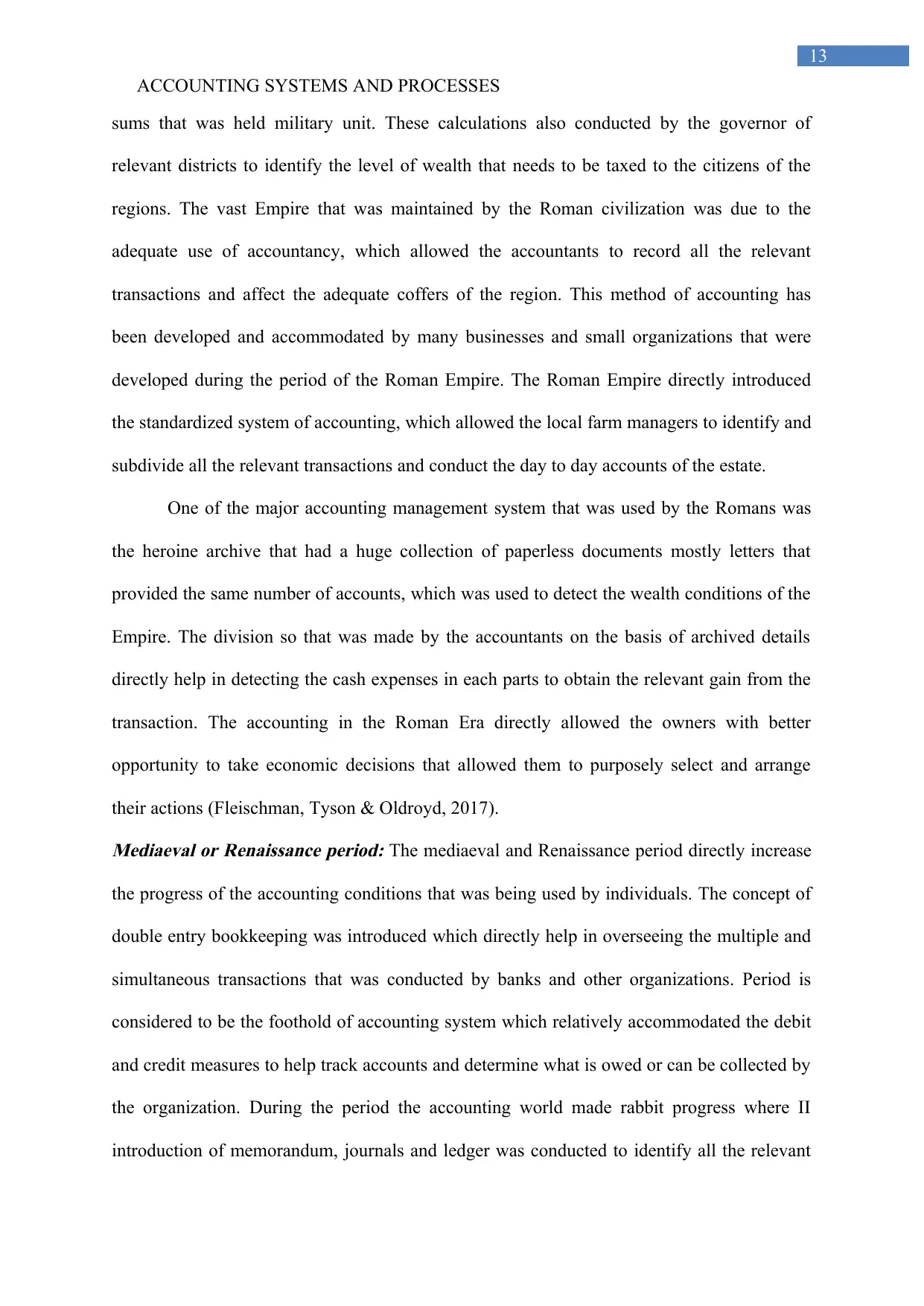
ACCOUNTING SYSTEMS AND PROCESSES
13
sums that was held military unit. These calculations also conducted by the governor of
relevant districts to identify the level of wealth that needs to be taxed to the citizens of the
regions. The vast Empire that was maintained by the Roman civilization was due to the
adequate use of accountancy, which allowed the accountants to record all the relevant
transactions and affect the adequate coffers of the region. This method of accounting has
been developed and accommodated by many businesses and small organizations that were
developed during the period of the Roman Empire. The Roman Empire directly introduced
the standardized system of accounting, which allowed the local farm managers to identify and
subdivide all the relevant transactions and conduct the day to day accounts of the estate.
One of the major accounting management system that was used by the Romans was
the heroine archive that had a huge collection of paperless documents mostly letters that
provided the same number of accounts, which was used to detect the wealth conditions of the
Empire. The division so that was made by the accountants on the basis of archived details
directly help in detecting the cash expenses in each parts to obtain the relevant gain from the
transaction. The accounting in the Roman Era directly allowed the owners with better
opportunity to take economic decisions that allowed them to purposely select and arrange
their actions (Fleischman, Tyson & Oldroyd, 2017).
Mediaeval or Renaissance period: The mediaeval and Renaissance period directly increase
the progress of the accounting conditions that was being used by individuals. The concept of
double entry bookkeeping was introduced which directly help in overseeing the multiple and
simultaneous transactions that was conducted by banks and other organizations. Period is
considered to be the foothold of accounting system which relatively accommodated the debit
and credit measures to help track accounts and determine what is owed or can be collected by
the organization. During the period the accounting world made rabbit progress where II
introduction of memorandum, journals and ledger was conducted to identify all the relevant
13
sums that was held military unit. These calculations also conducted by the governor of
relevant districts to identify the level of wealth that needs to be taxed to the citizens of the
regions. The vast Empire that was maintained by the Roman civilization was due to the
adequate use of accountancy, which allowed the accountants to record all the relevant
transactions and affect the adequate coffers of the region. This method of accounting has
been developed and accommodated by many businesses and small organizations that were
developed during the period of the Roman Empire. The Roman Empire directly introduced
the standardized system of accounting, which allowed the local farm managers to identify and
subdivide all the relevant transactions and conduct the day to day accounts of the estate.
One of the major accounting management system that was used by the Romans was
the heroine archive that had a huge collection of paperless documents mostly letters that
provided the same number of accounts, which was used to detect the wealth conditions of the
Empire. The division so that was made by the accountants on the basis of archived details
directly help in detecting the cash expenses in each parts to obtain the relevant gain from the
transaction. The accounting in the Roman Era directly allowed the owners with better
opportunity to take economic decisions that allowed them to purposely select and arrange
their actions (Fleischman, Tyson & Oldroyd, 2017).
Mediaeval or Renaissance period: The mediaeval and Renaissance period directly increase
the progress of the accounting conditions that was being used by individuals. The concept of
double entry bookkeeping was introduced which directly help in overseeing the multiple and
simultaneous transactions that was conducted by banks and other organizations. Period is
considered to be the foothold of accounting system which relatively accommodated the debit
and credit measures to help track accounts and determine what is owed or can be collected by
the organization. During the period the accounting world made rabbit progress where II
introduction of memorandum, journals and ledger was conducted to identify all the relevant
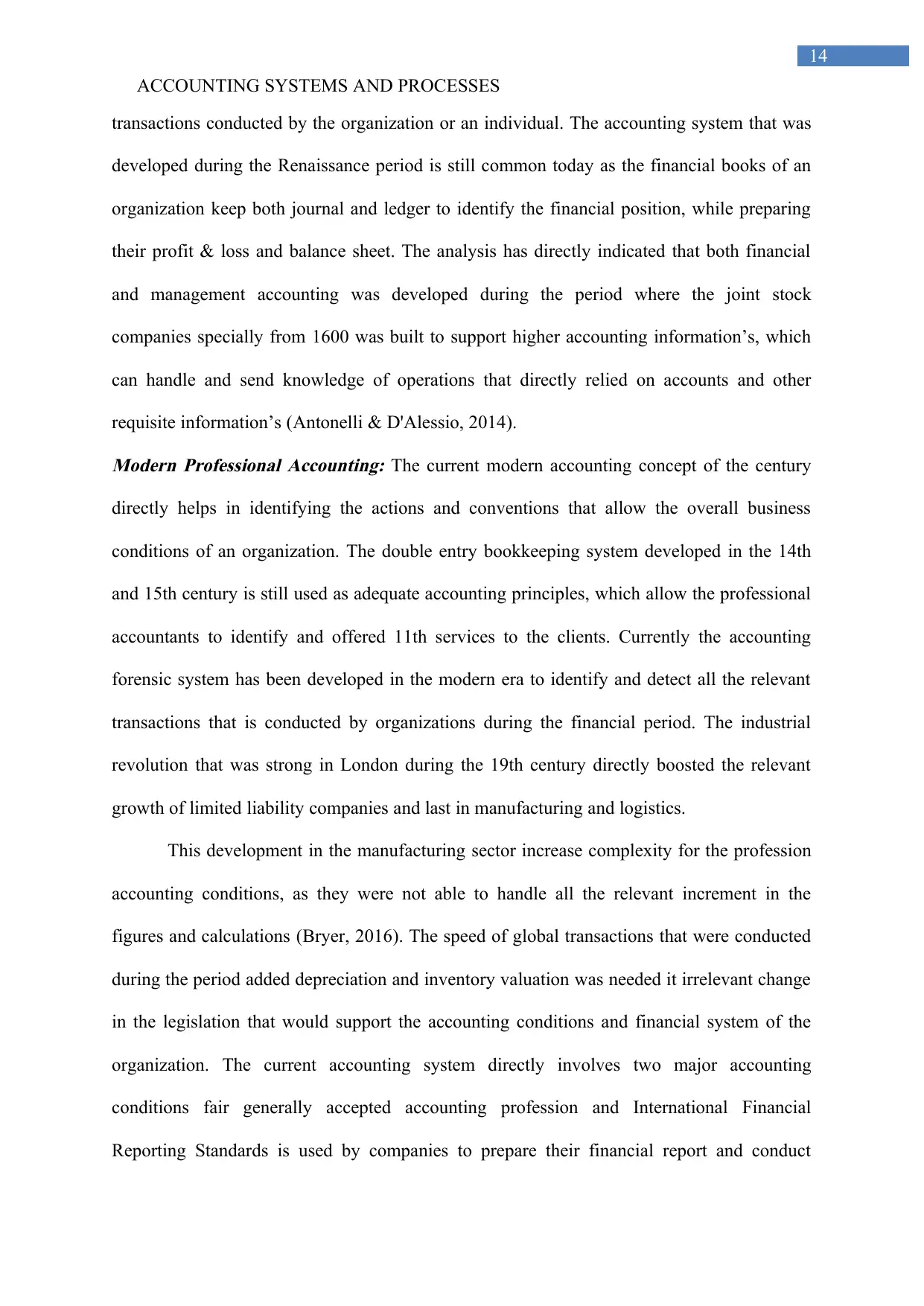
ACCOUNTING SYSTEMS AND PROCESSES
14
transactions conducted by the organization or an individual. The accounting system that was
developed during the Renaissance period is still common today as the financial books of an
organization keep both journal and ledger to identify the financial position, while preparing
their profit & loss and balance sheet. The analysis has directly indicated that both financial
and management accounting was developed during the period where the joint stock
companies specially from 1600 was built to support higher accounting information’s, which
can handle and send knowledge of operations that directly relied on accounts and other
requisite information’s (Antonelli & D'Alessio, 2014).
Modern Professional Accounting: The current modern accounting concept of the century
directly helps in identifying the actions and conventions that allow the overall business
conditions of an organization. The double entry bookkeeping system developed in the 14th
and 15th century is still used as adequate accounting principles, which allow the professional
accountants to identify and offered 11th services to the clients. Currently the accounting
forensic system has been developed in the modern era to identify and detect all the relevant
transactions that is conducted by organizations during the financial period. The industrial
revolution that was strong in London during the 19th century directly boosted the relevant
growth of limited liability companies and last in manufacturing and logistics.
This development in the manufacturing sector increase complexity for the profession
accounting conditions, as they were not able to handle all the relevant increment in the
figures and calculations (Bryer, 2016). The speed of global transactions that were conducted
during the period added depreciation and inventory valuation was needed it irrelevant change
in the legislation that would support the accounting conditions and financial system of the
organization. The current accounting system directly involves two major accounting
conditions fair generally accepted accounting profession and International Financial
Reporting Standards is used by companies to prepare their financial report and conduct
14
transactions conducted by the organization or an individual. The accounting system that was
developed during the Renaissance period is still common today as the financial books of an
organization keep both journal and ledger to identify the financial position, while preparing
their profit & loss and balance sheet. The analysis has directly indicated that both financial
and management accounting was developed during the period where the joint stock
companies specially from 1600 was built to support higher accounting information’s, which
can handle and send knowledge of operations that directly relied on accounts and other
requisite information’s (Antonelli & D'Alessio, 2014).
Modern Professional Accounting: The current modern accounting concept of the century
directly helps in identifying the actions and conventions that allow the overall business
conditions of an organization. The double entry bookkeeping system developed in the 14th
and 15th century is still used as adequate accounting principles, which allow the professional
accountants to identify and offered 11th services to the clients. Currently the accounting
forensic system has been developed in the modern era to identify and detect all the relevant
transactions that is conducted by organizations during the financial period. The industrial
revolution that was strong in London during the 19th century directly boosted the relevant
growth of limited liability companies and last in manufacturing and logistics.
This development in the manufacturing sector increase complexity for the profession
accounting conditions, as they were not able to handle all the relevant increment in the
figures and calculations (Bryer, 2016). The speed of global transactions that were conducted
during the period added depreciation and inventory valuation was needed it irrelevant change
in the legislation that would support the accounting conditions and financial system of the
organization. The current accounting system directly involves two major accounting
conditions fair generally accepted accounting profession and International Financial
Reporting Standards is used by companies to prepare their financial report and conduct
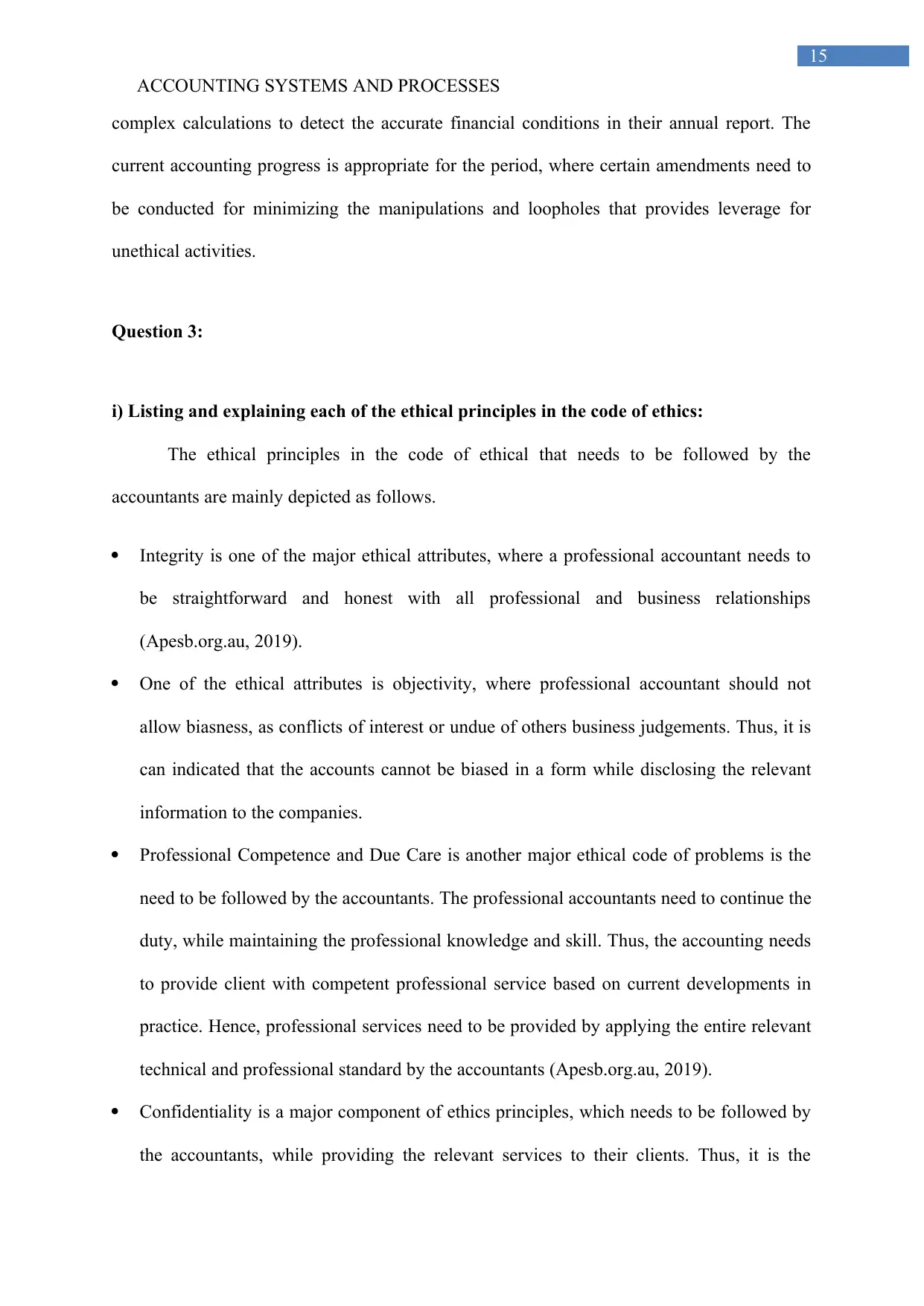
ACCOUNTING SYSTEMS AND PROCESSES
15
complex calculations to detect the accurate financial conditions in their annual report. The
current accounting progress is appropriate for the period, where certain amendments need to
be conducted for minimizing the manipulations and loopholes that provides leverage for
unethical activities.
Question 3:
i) Listing and explaining each of the ethical principles in the code of ethics:
The ethical principles in the code of ethical that needs to be followed by the
accountants are mainly depicted as follows.
Integrity is one of the major ethical attributes, where a professional accountant needs to
be straightforward and honest with all professional and business relationships
(Apesb.org.au, 2019).
One of the ethical attributes is objectivity, where professional accountant should not
allow biasness, as conflicts of interest or undue of others business judgements. Thus, it is
can indicated that the accounts cannot be biased in a form while disclosing the relevant
information to the companies.
Professional Competence and Due Care is another major ethical code of problems is the
need to be followed by the accountants. The professional accountants need to continue the
duty, while maintaining the professional knowledge and skill. Thus, the accounting needs
to provide client with competent professional service based on current developments in
practice. Hence, professional services need to be provided by applying the entire relevant
technical and professional standard by the accountants (Apesb.org.au, 2019).
Confidentiality is a major component of ethics principles, which needs to be followed by
the accountants, while providing the relevant services to their clients. Thus, it is the
15
complex calculations to detect the accurate financial conditions in their annual report. The
current accounting progress is appropriate for the period, where certain amendments need to
be conducted for minimizing the manipulations and loopholes that provides leverage for
unethical activities.
Question 3:
i) Listing and explaining each of the ethical principles in the code of ethics:
The ethical principles in the code of ethical that needs to be followed by the
accountants are mainly depicted as follows.
Integrity is one of the major ethical attributes, where a professional accountant needs to
be straightforward and honest with all professional and business relationships
(Apesb.org.au, 2019).
One of the ethical attributes is objectivity, where professional accountant should not
allow biasness, as conflicts of interest or undue of others business judgements. Thus, it is
can indicated that the accounts cannot be biased in a form while disclosing the relevant
information to the companies.
Professional Competence and Due Care is another major ethical code of problems is the
need to be followed by the accountants. The professional accountants need to continue the
duty, while maintaining the professional knowledge and skill. Thus, the accounting needs
to provide client with competent professional service based on current developments in
practice. Hence, professional services need to be provided by applying the entire relevant
technical and professional standard by the accountants (Apesb.org.au, 2019).
Confidentiality is a major component of ethics principles, which needs to be followed by
the accountants, while providing the relevant services to their clients. Thus, it is the
Secure Best Marks with AI Grader
Need help grading? Try our AI Grader for instant feedback on your assignments.
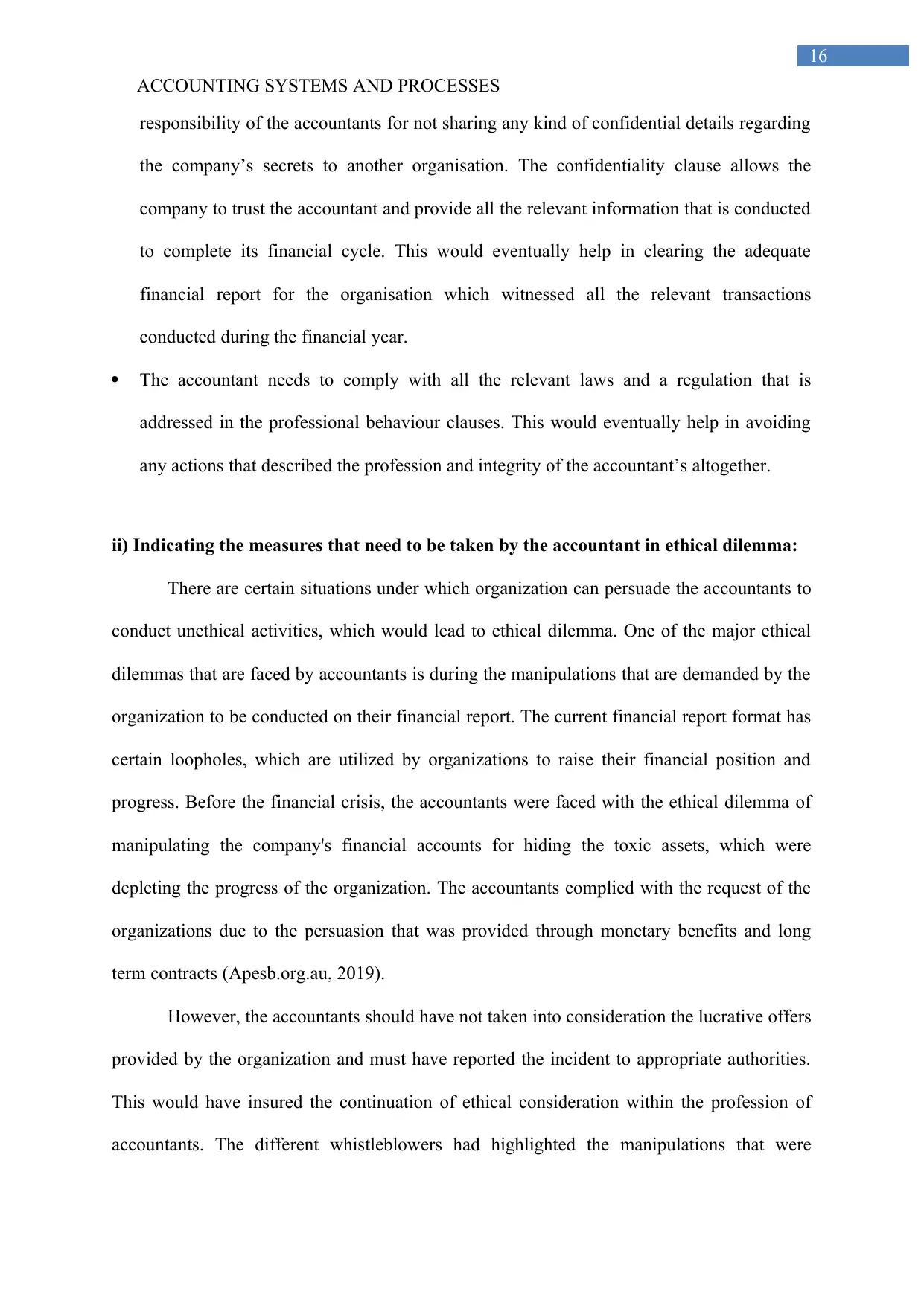
ACCOUNTING SYSTEMS AND PROCESSES
16
responsibility of the accountants for not sharing any kind of confidential details regarding
the company’s secrets to another organisation. The confidentiality clause allows the
company to trust the accountant and provide all the relevant information that is conducted
to complete its financial cycle. This would eventually help in clearing the adequate
financial report for the organisation which witnessed all the relevant transactions
conducted during the financial year.
The accountant needs to comply with all the relevant laws and a regulation that is
addressed in the professional behaviour clauses. This would eventually help in avoiding
any actions that described the profession and integrity of the accountant’s altogether.
ii) Indicating the measures that need to be taken by the accountant in ethical dilemma:
There are certain situations under which organization can persuade the accountants to
conduct unethical activities, which would lead to ethical dilemma. One of the major ethical
dilemmas that are faced by accountants is during the manipulations that are demanded by the
organization to be conducted on their financial report. The current financial report format has
certain loopholes, which are utilized by organizations to raise their financial position and
progress. Before the financial crisis, the accountants were faced with the ethical dilemma of
manipulating the company's financial accounts for hiding the toxic assets, which were
depleting the progress of the organization. The accountants complied with the request of the
organizations due to the persuasion that was provided through monetary benefits and long
term contracts (Apesb.org.au, 2019).
However, the accountants should have not taken into consideration the lucrative offers
provided by the organization and must have reported the incident to appropriate authorities.
This would have insured the continuation of ethical consideration within the profession of
accountants. The different whistleblowers had highlighted the manipulations that were
16
responsibility of the accountants for not sharing any kind of confidential details regarding
the company’s secrets to another organisation. The confidentiality clause allows the
company to trust the accountant and provide all the relevant information that is conducted
to complete its financial cycle. This would eventually help in clearing the adequate
financial report for the organisation which witnessed all the relevant transactions
conducted during the financial year.
The accountant needs to comply with all the relevant laws and a regulation that is
addressed in the professional behaviour clauses. This would eventually help in avoiding
any actions that described the profession and integrity of the accountant’s altogether.
ii) Indicating the measures that need to be taken by the accountant in ethical dilemma:
There are certain situations under which organization can persuade the accountants to
conduct unethical activities, which would lead to ethical dilemma. One of the major ethical
dilemmas that are faced by accountants is during the manipulations that are demanded by the
organization to be conducted on their financial report. The current financial report format has
certain loopholes, which are utilized by organizations to raise their financial position and
progress. Before the financial crisis, the accountants were faced with the ethical dilemma of
manipulating the company's financial accounts for hiding the toxic assets, which were
depleting the progress of the organization. The accountants complied with the request of the
organizations due to the persuasion that was provided through monetary benefits and long
term contracts (Apesb.org.au, 2019).
However, the accountants should have not taken into consideration the lucrative offers
provided by the organization and must have reported the incident to appropriate authorities.
This would have insured the continuation of ethical consideration within the profession of
accountants. The different whistleblowers had highlighted the manipulations that were
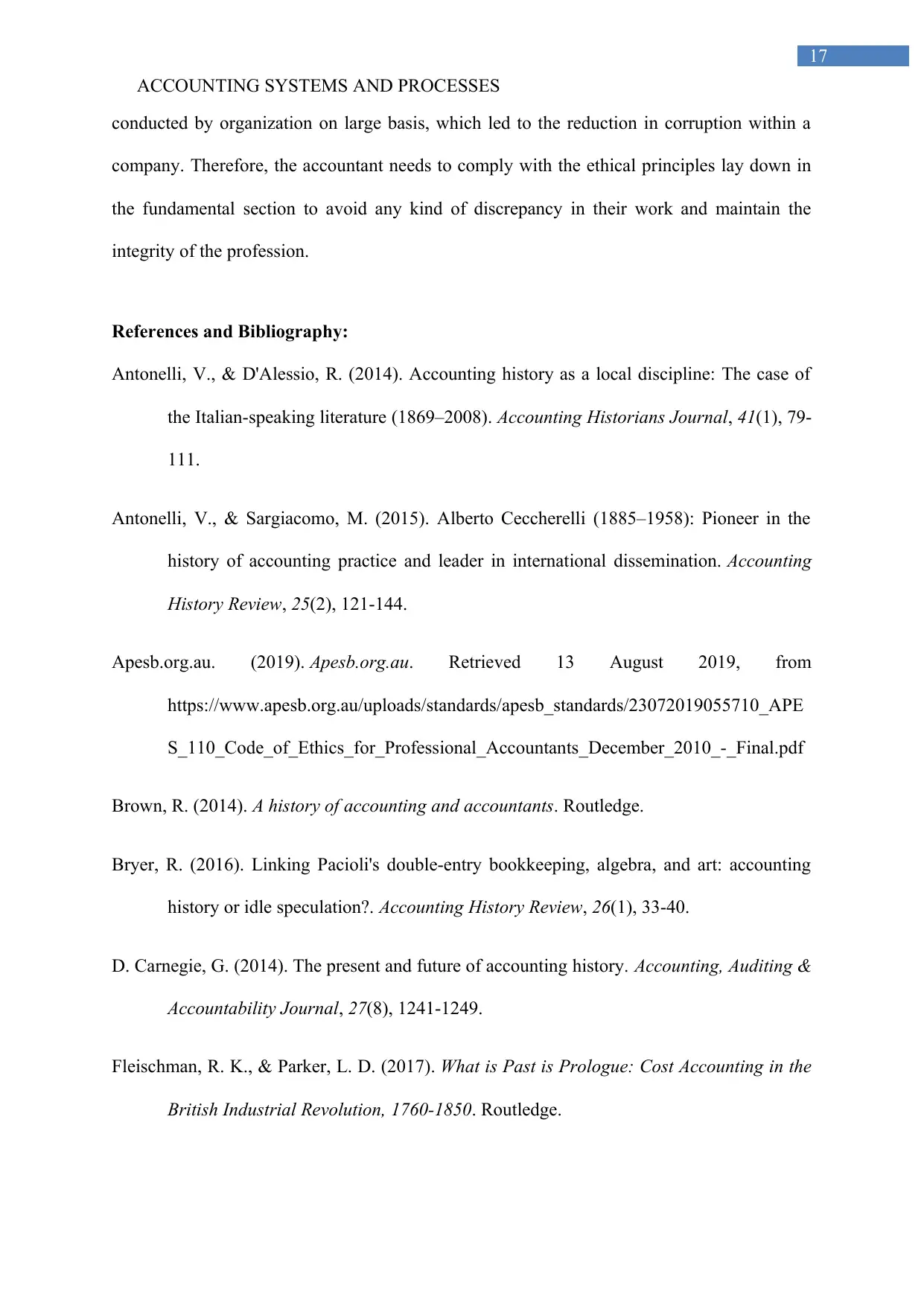
ACCOUNTING SYSTEMS AND PROCESSES
17
conducted by organization on large basis, which led to the reduction in corruption within a
company. Therefore, the accountant needs to comply with the ethical principles lay down in
the fundamental section to avoid any kind of discrepancy in their work and maintain the
integrity of the profession.
References and Bibliography:
Antonelli, V., & D'Alessio, R. (2014). Accounting history as a local discipline: The case of
the Italian-speaking literature (1869–2008). Accounting Historians Journal, 41(1), 79-
111.
Antonelli, V., & Sargiacomo, M. (2015). Alberto Ceccherelli (1885–1958): Pioneer in the
history of accounting practice and leader in international dissemination. Accounting
History Review, 25(2), 121-144.
Apesb.org.au. (2019). Apesb.org.au. Retrieved 13 August 2019, from
https://www.apesb.org.au/uploads/standards/apesb_standards/23072019055710_APE
S_110_Code_of_Ethics_for_Professional_Accountants_December_2010_-_Final.pdf
Brown, R. (2014). A history of accounting and accountants. Routledge.
Bryer, R. (2016). Linking Pacioli's double-entry bookkeeping, algebra, and art: accounting
history or idle speculation?. Accounting History Review, 26(1), 33-40.
D. Carnegie, G. (2014). The present and future of accounting history. Accounting, Auditing &
Accountability Journal, 27(8), 1241-1249.
Fleischman, R. K., & Parker, L. D. (2017). What is Past is Prologue: Cost Accounting in the
British Industrial Revolution, 1760-1850. Routledge.
17
conducted by organization on large basis, which led to the reduction in corruption within a
company. Therefore, the accountant needs to comply with the ethical principles lay down in
the fundamental section to avoid any kind of discrepancy in their work and maintain the
integrity of the profession.
References and Bibliography:
Antonelli, V., & D'Alessio, R. (2014). Accounting history as a local discipline: The case of
the Italian-speaking literature (1869–2008). Accounting Historians Journal, 41(1), 79-
111.
Antonelli, V., & Sargiacomo, M. (2015). Alberto Ceccherelli (1885–1958): Pioneer in the
history of accounting practice and leader in international dissemination. Accounting
History Review, 25(2), 121-144.
Apesb.org.au. (2019). Apesb.org.au. Retrieved 13 August 2019, from
https://www.apesb.org.au/uploads/standards/apesb_standards/23072019055710_APE
S_110_Code_of_Ethics_for_Professional_Accountants_December_2010_-_Final.pdf
Brown, R. (2014). A history of accounting and accountants. Routledge.
Bryer, R. (2016). Linking Pacioli's double-entry bookkeeping, algebra, and art: accounting
history or idle speculation?. Accounting History Review, 26(1), 33-40.
D. Carnegie, G. (2014). The present and future of accounting history. Accounting, Auditing &
Accountability Journal, 27(8), 1241-1249.
Fleischman, R. K., & Parker, L. D. (2017). What is Past is Prologue: Cost Accounting in the
British Industrial Revolution, 1760-1850. Routledge.
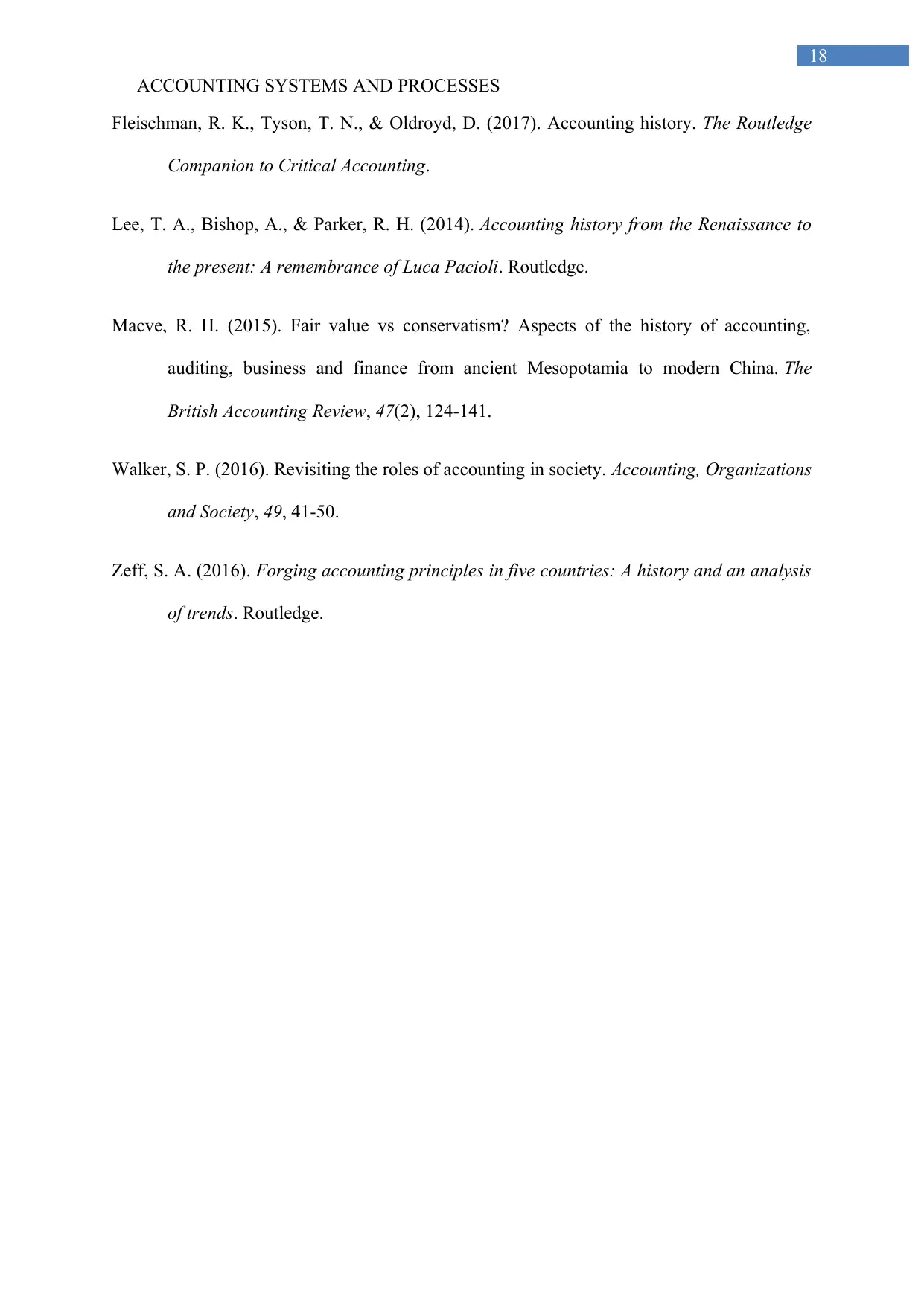
ACCOUNTING SYSTEMS AND PROCESSES
18
Fleischman, R. K., Tyson, T. N., & Oldroyd, D. (2017). Accounting history. The Routledge
Companion to Critical Accounting.
Lee, T. A., Bishop, A., & Parker, R. H. (2014). Accounting history from the Renaissance to
the present: A remembrance of Luca Pacioli. Routledge.
Macve, R. H. (2015). Fair value vs conservatism? Aspects of the history of accounting,
auditing, business and finance from ancient Mesopotamia to modern China. The
British Accounting Review, 47(2), 124-141.
Walker, S. P. (2016). Revisiting the roles of accounting in society. Accounting, Organizations
and Society, 49, 41-50.
Zeff, S. A. (2016). Forging accounting principles in five countries: A history and an analysis
of trends. Routledge.
18
Fleischman, R. K., Tyson, T. N., & Oldroyd, D. (2017). Accounting history. The Routledge
Companion to Critical Accounting.
Lee, T. A., Bishop, A., & Parker, R. H. (2014). Accounting history from the Renaissance to
the present: A remembrance of Luca Pacioli. Routledge.
Macve, R. H. (2015). Fair value vs conservatism? Aspects of the history of accounting,
auditing, business and finance from ancient Mesopotamia to modern China. The
British Accounting Review, 47(2), 124-141.
Walker, S. P. (2016). Revisiting the roles of accounting in society. Accounting, Organizations
and Society, 49, 41-50.
Zeff, S. A. (2016). Forging accounting principles in five countries: A history and an analysis
of trends. Routledge.
1 out of 19
Related Documents
Your All-in-One AI-Powered Toolkit for Academic Success.
+13062052269
info@desklib.com
Available 24*7 on WhatsApp / Email
![[object Object]](/_next/static/media/star-bottom.7253800d.svg)
Unlock your academic potential
© 2024 | Zucol Services PVT LTD | All rights reserved.





